If this is your first time hiking in Banff, the trails might be pretty intimidating. The Canadian Rockies are gorgeous, but they are also tall, steep, and dangerous. If you’re wondering if it is safe to hike in Banff, we want to help ease you into hiking in the Rockies, with our personal tips for getting after it and having fun on the trail.
Tips for First Timers Hiking in Banff
Choose The Right Trail
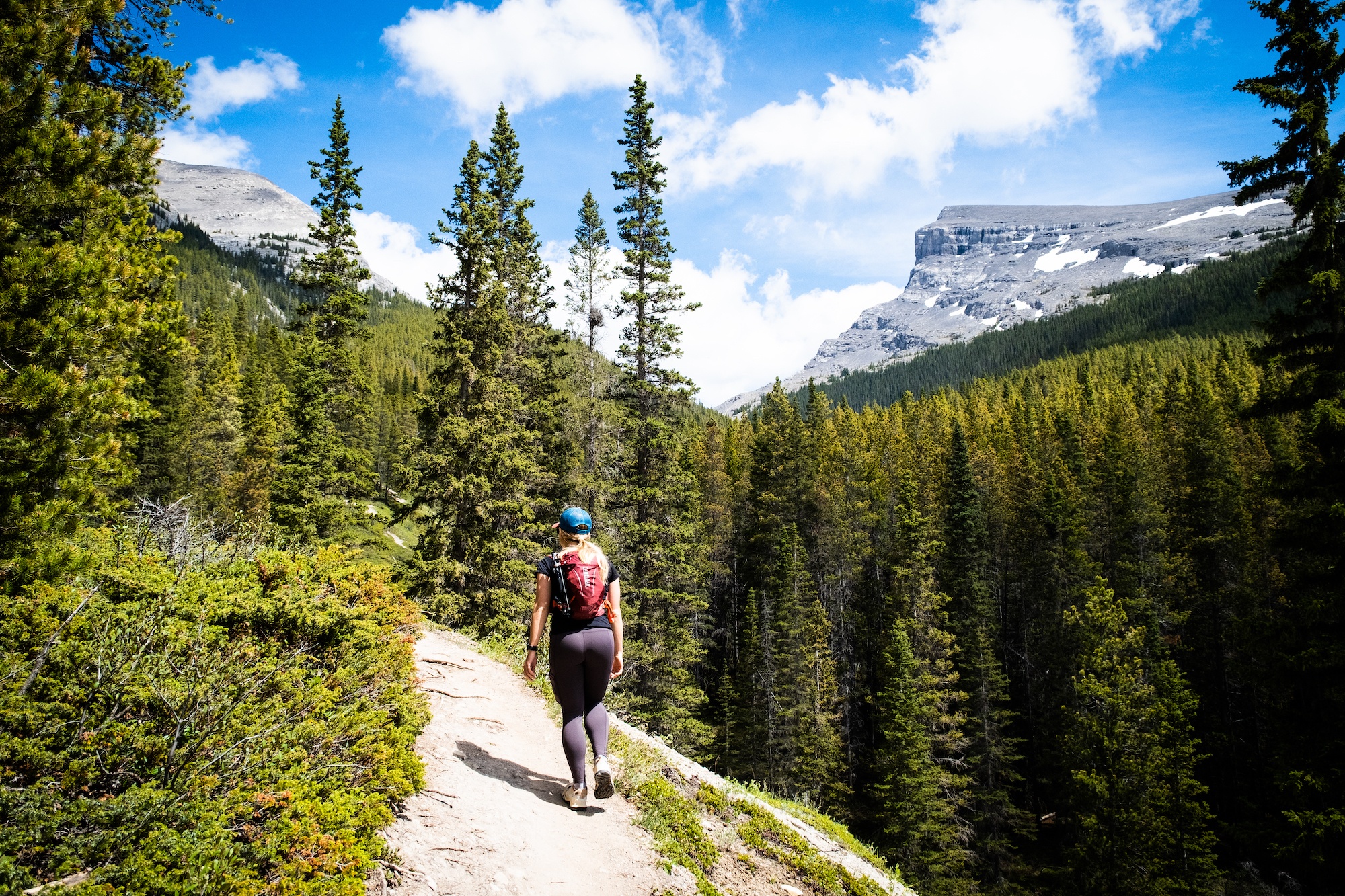
The first thing any new hiker needs to do is choose the best Banff hiking trail for them and their abilities. That means paying attention to things like distance, elevation, average time, logistics, routing, and considering their physical fitness ability. Remember that everyone hikes at different paces and abilities, so what works for your friend may not work for you.
- Distance: Look up the hike you want to do on AllTrails, (blogs – wink wink) and local guidebooks and take note of the length and decide if you have it in you to go 5km, 10km, 15 km, etc.
- Elevation: It’s not only distance you have to look at but elevation. See what the elevation gain is on AllTrails and hiking guidebooks to determine how much incline you can handle for the day. Some of the hikes here are short in km, but have crazy elevation gain, so make sure you’re looking at that.
- Time: Read reviews and see what the average person is completing the hike in to determine how much time it will take you. I also ask Facebook groups or read helpful blogs (like this one!) to decide on average time.
- Weather: I’ll go into this more later, but make sure to check the weather before heading out. It will significantly affect your movement.
- Fitness Ability: Are you physically fit, or do you usually move a little slower? Take into account your fitness when picking out a Banff hiking trail.
- Logistics: Is the trailhead hard to find? Do you have to drive hours to reach it? Will you have to bushwack to get to a path? Will you be out of service the entire time? These are all things to consider when picking a hiking trail in Banff.
Study The Route
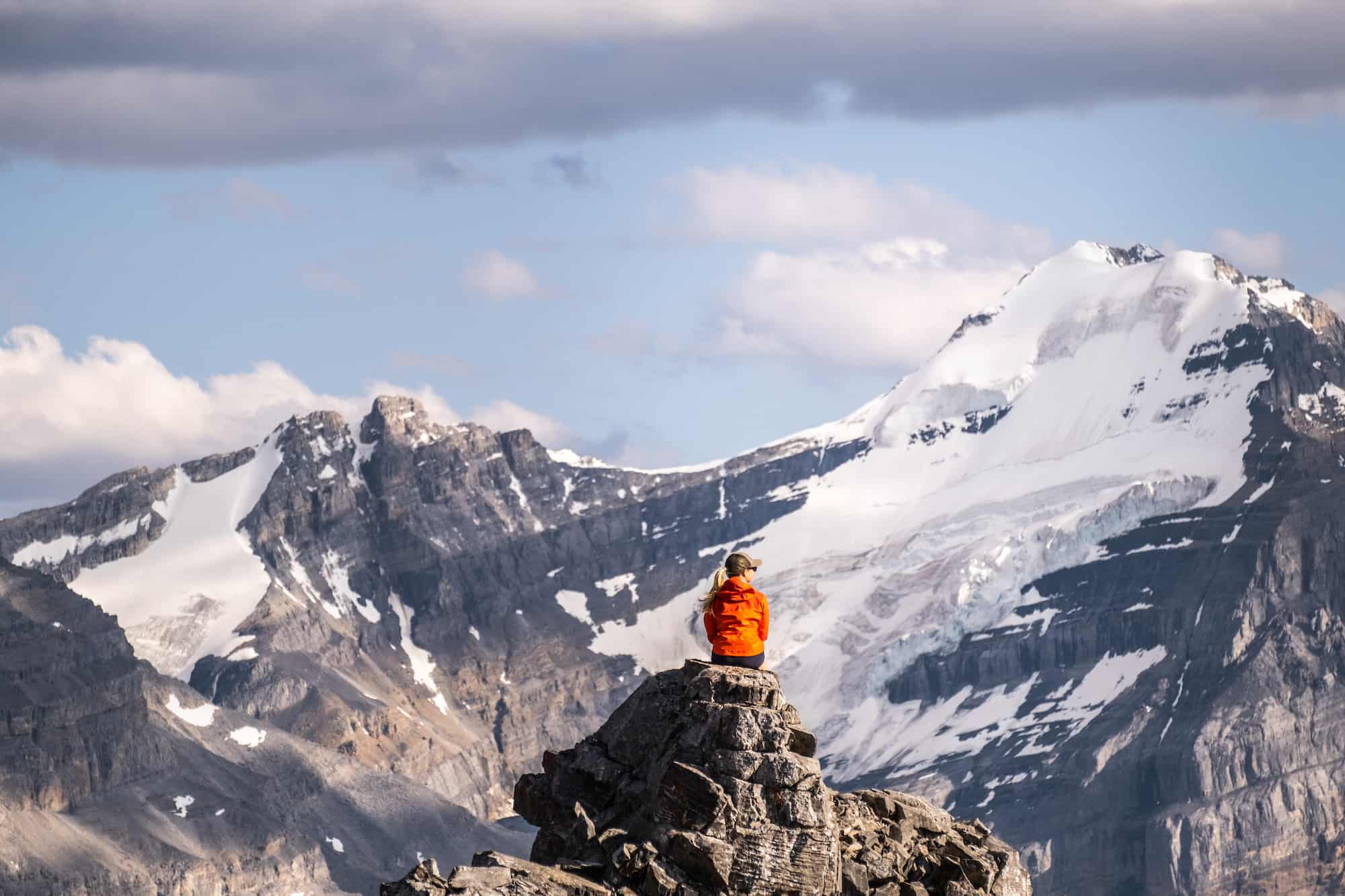
AllTrails is my favorite app to use when planning out my hike. I suggest downloading it and paying for a subscription so you can download their topography maps right to your phone and access them offline.
It’s by no means perfect, it’s an app so I have my critiques. However AllTrails provides a lot of the info you’ll need on most hikes in the area, including helpful details like the start of the trailhead, elevation, elevation gain, average time, and distance.
I also love reading reviews for critical things I need to know. It’s one tool in our arsenal to determine our route. However, I do not recommend the app as your only tool, as the routes and details have often been off in our experience. Its greatest strength is user-submitted reviews that provide insight into trail conditions.
If you prefer to use a guidebook, you can use Alan Kane’s scramble books or a Canadian Rockies trail guidebook. I’d also recommend a paper map of the region to better understand the geography/topography of your route.
Over the years I’ve become obsessed with identifying the names of peaks and valleys (Peak Finder is great for this) — the result means you could drop me in many areas of the park and I could navigate with little to no tools.
Plan Your Route
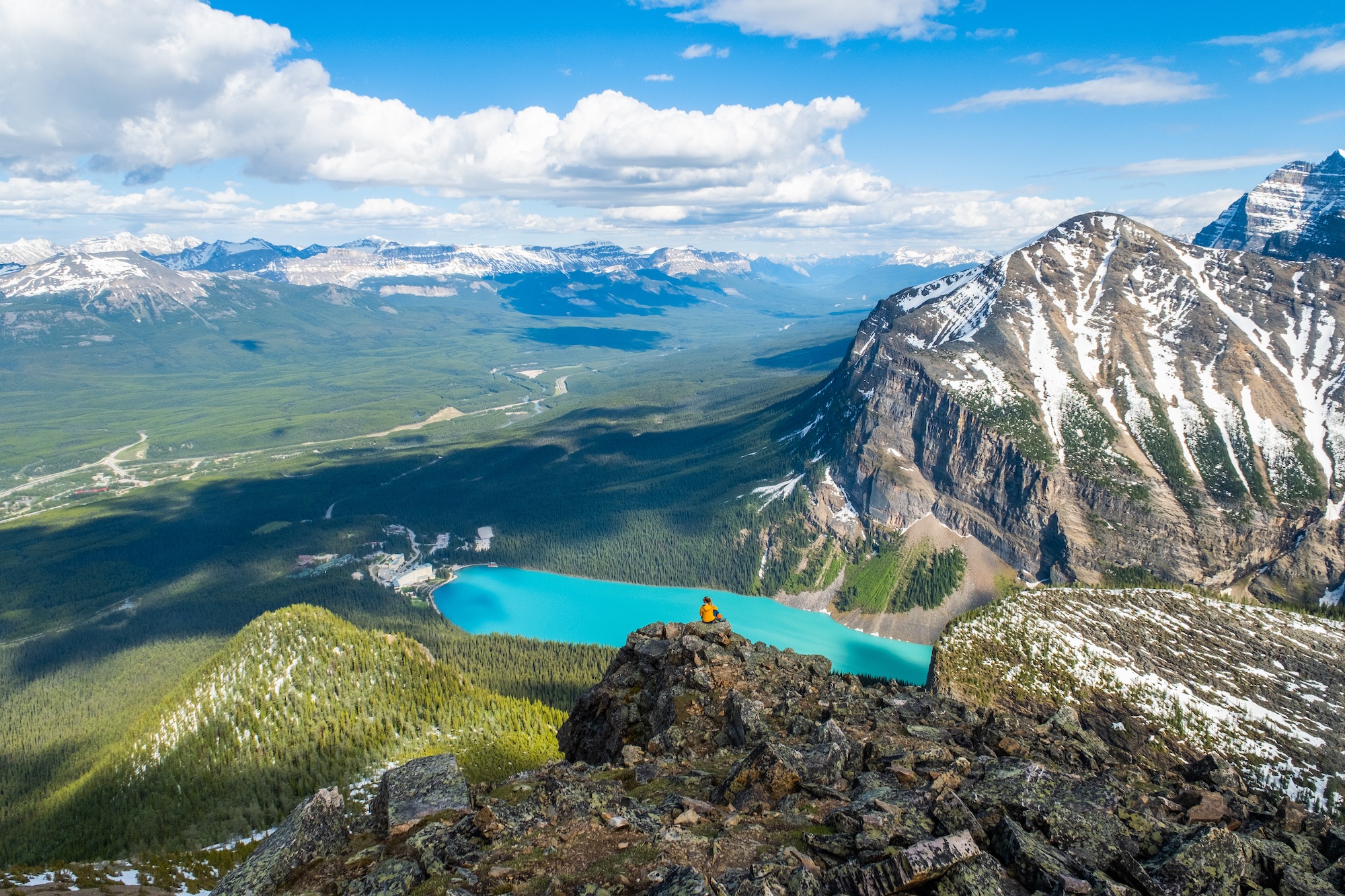
After you’ve picked out your trail, it’s time to plan your hiking trip. For me, this means picking a day when the weather will be nice, packing what I think I will need for the duration and scale of the hike, and hopefully finding a few buddies to tag along!
Hiking Gear We Recommend
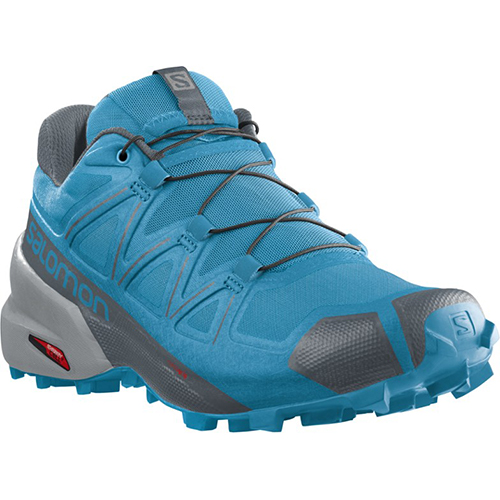
The vast majority of hikes and easy scrambles in the Rockies, you’ll find us in our trusty Salomon Speedcross.
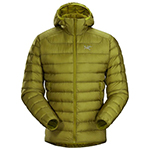
Arc’teryx Cerium is our pick for the best down jacket. It’s incredibly light, and we bring it on almost every hike in the Rockies.
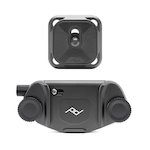
This nifty clip from Peak Design secures a camera to my backpack strap for easy reach. No more digging in the backpack!
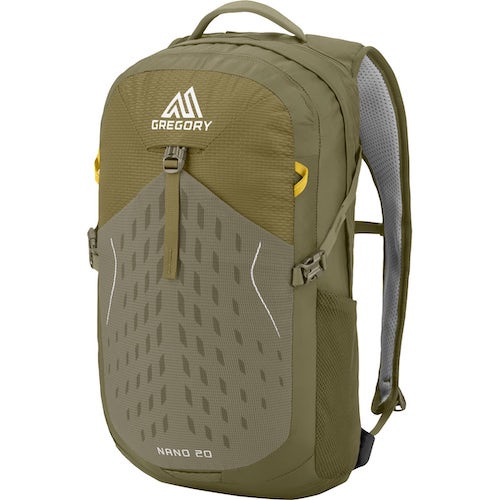
20L feels like the ideal size for quick hikes and scrambles. We love the Nano from Gregory with a hydration reservoir.
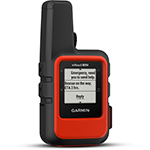
There is not much cell service in the Canadian Rockies. In case of emergencies, we carry an emergency beacon with GPS.
Check the Weather
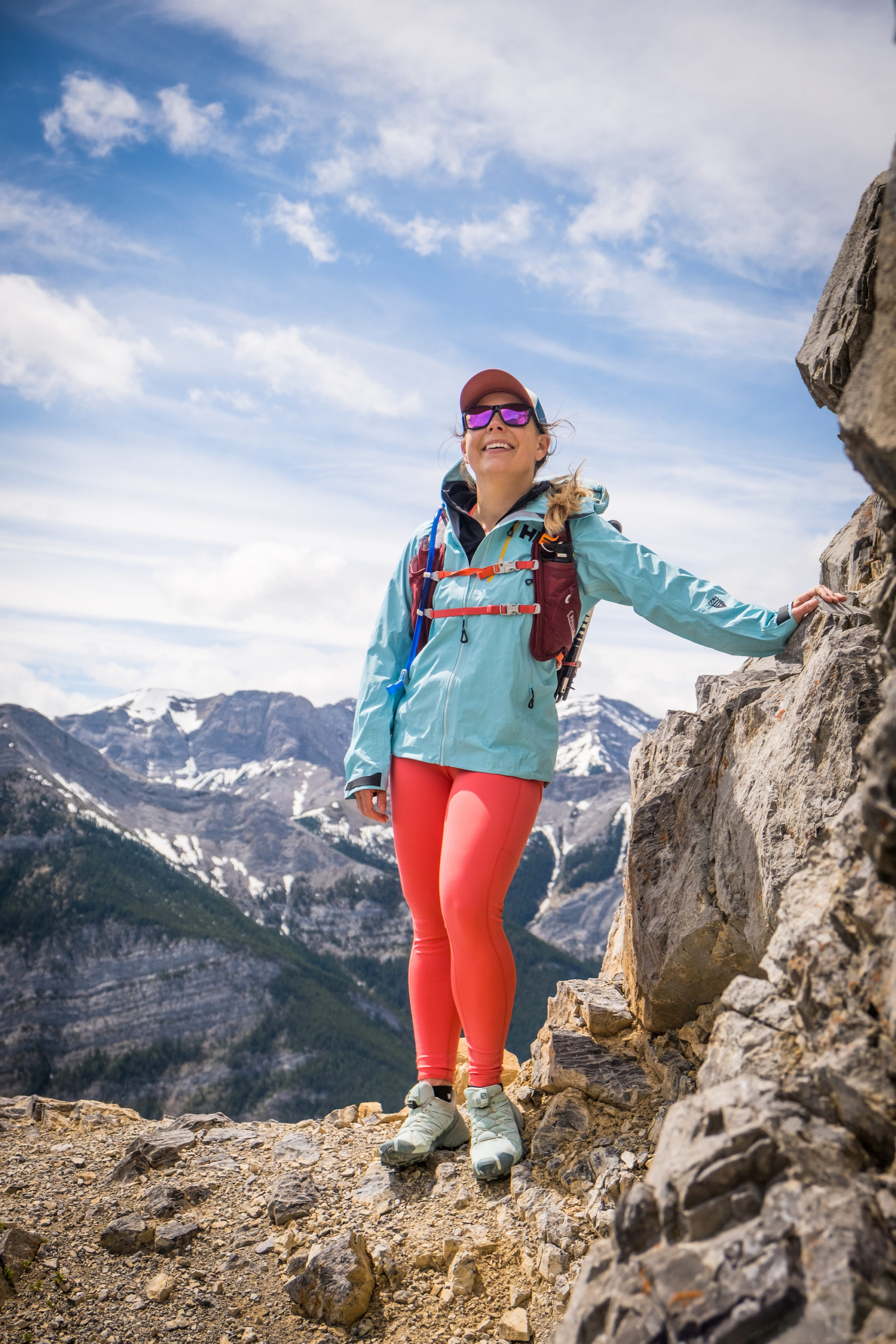
Any hiker, especially a newbie, must pay attention to the weather – it’s imperative for staying safe on a hike in Banff. If there’s one thing I’ve learned from living in the Canadian Rockies, it’s to always be prepared for anything and everything. We’ve gotten snowed on in the middle of July before, and I was happy I had layers and a down jacket to keep me warm. It’s always down jacket season in the Rockies.
If you’re nervous about your first hike in Banff, pick a day when the weather looks like it will have optimal sunshine. And if you wake up and the weatherman is wrong, and it’s pouring rain, don’t hesitate to change your plans. While you’re on top of a mountain, thunderstorms, and lightning are things that don’t mix well.
Also – it’s best to stop relying on the Apple Weather app to plan your days. It’s often unreliable in the mountains. Windy is one of our favorite websites to plan our hikes around.
Tell Someone Your Plan
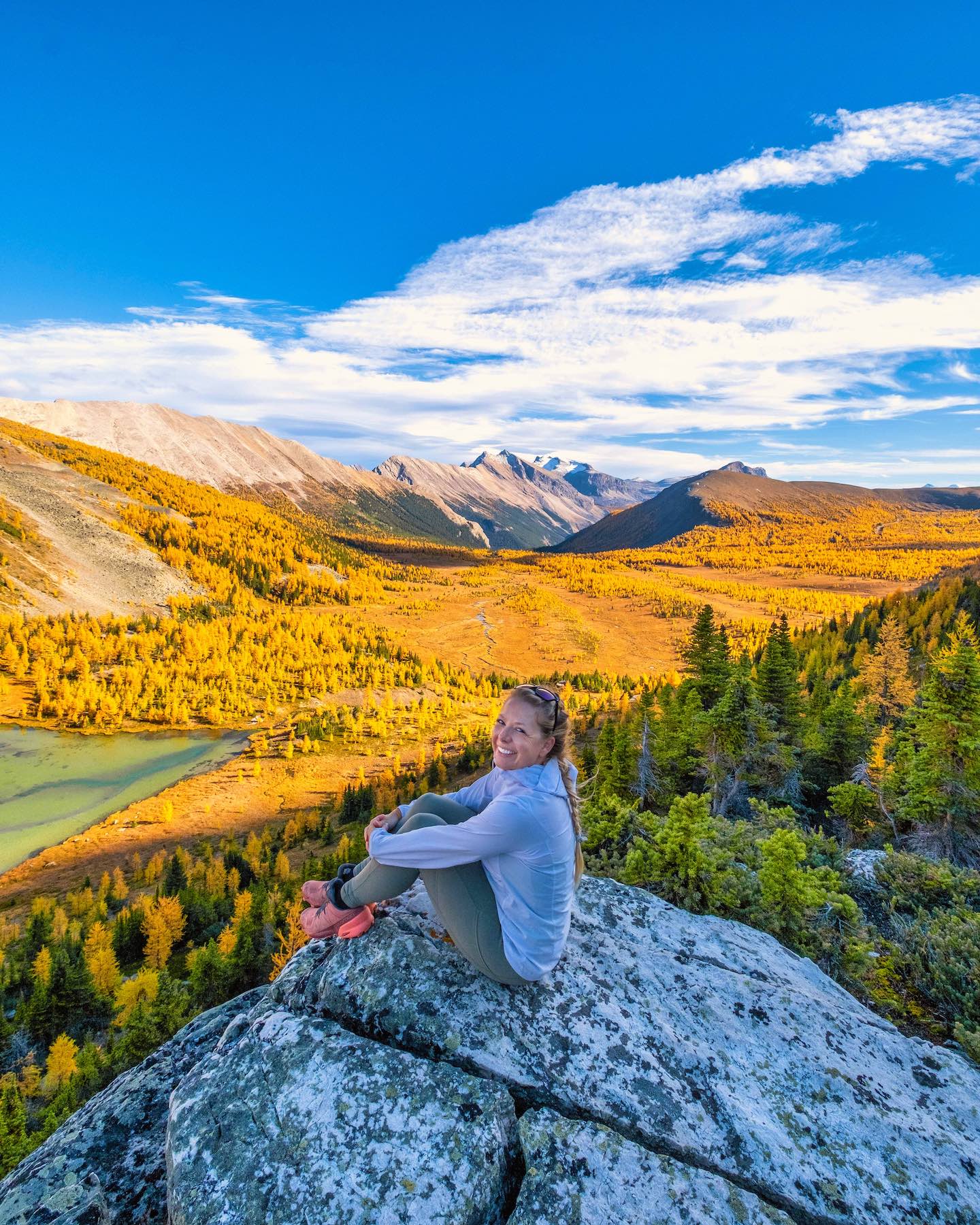
This is especially true if you are a new hiker who is going on a solo hike. You need to tell someone the hike you are setting out for, your start time, and the intended return time. That way, if something goes wrong and you don’t make it back, they can call Search and Rescue. It can even be a good idea to post to your Facebook or Instagram Stories before you set out to let your close followers know your intention.
Set Realistic Goals When Hiking in Banff
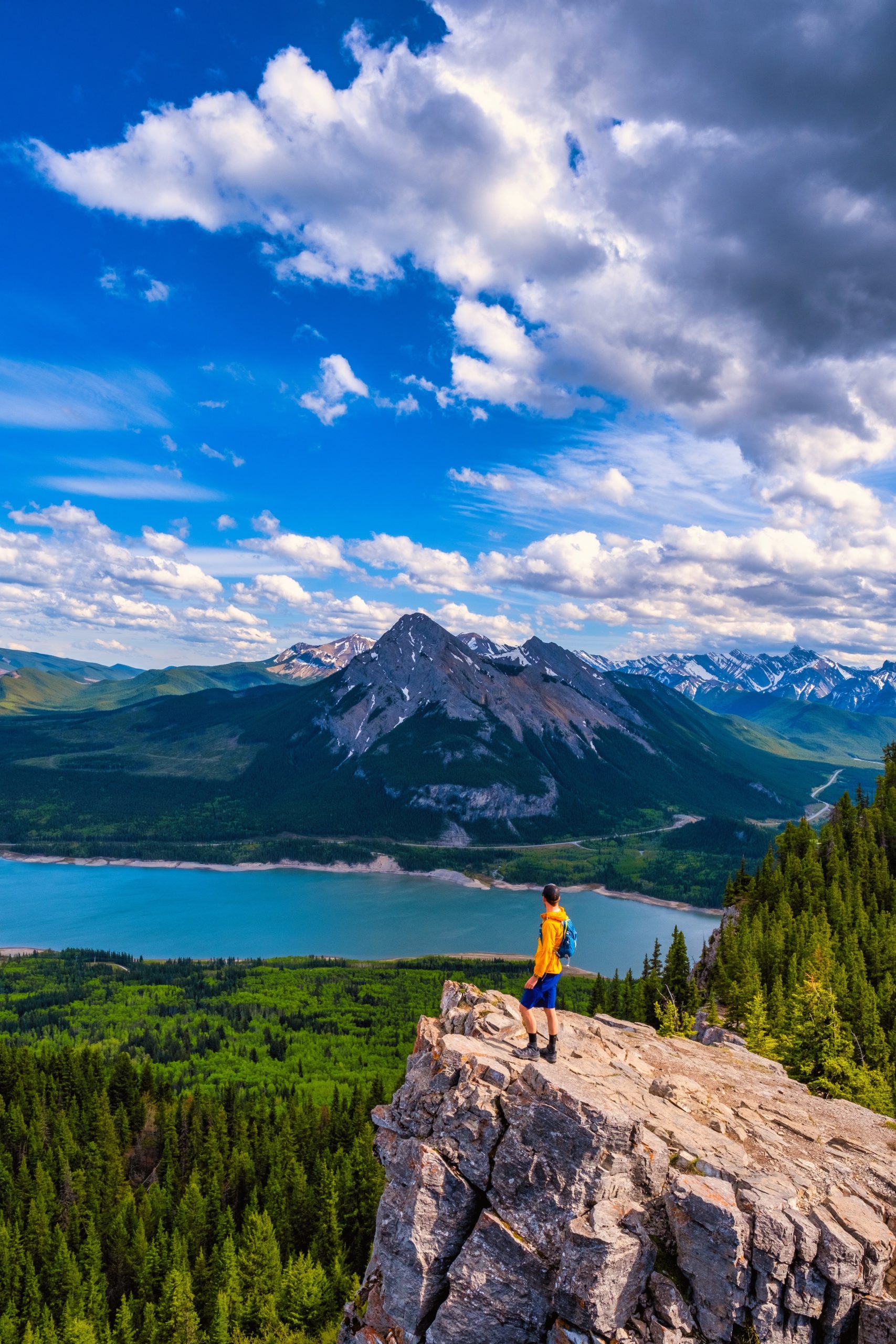
While bagging three peaks in one day or hiking 30 km may seem like a great idea, it’s not always attainable. One of my top beginner hiking tips is to set realistic goals and expectations. Disasters can happen when people set their expectations too high and feel the need to keep pushing themselves when they should have turned around.
Pack Right When Hiking in Banff
Packing right for your first hiking trip in the Rockies is key. In Alberta, this means layers and layers. When I am out on a day hike, I always pack a down jacket and rain jacket with me, no matter what. Then, depending on the hike, I may bring items like gaiters for snow, microspikes, hiking poles, extra socks, gloves, a buff, or a hat. You can see my full list of Banff hiking essentials here.
Don’t Overpack
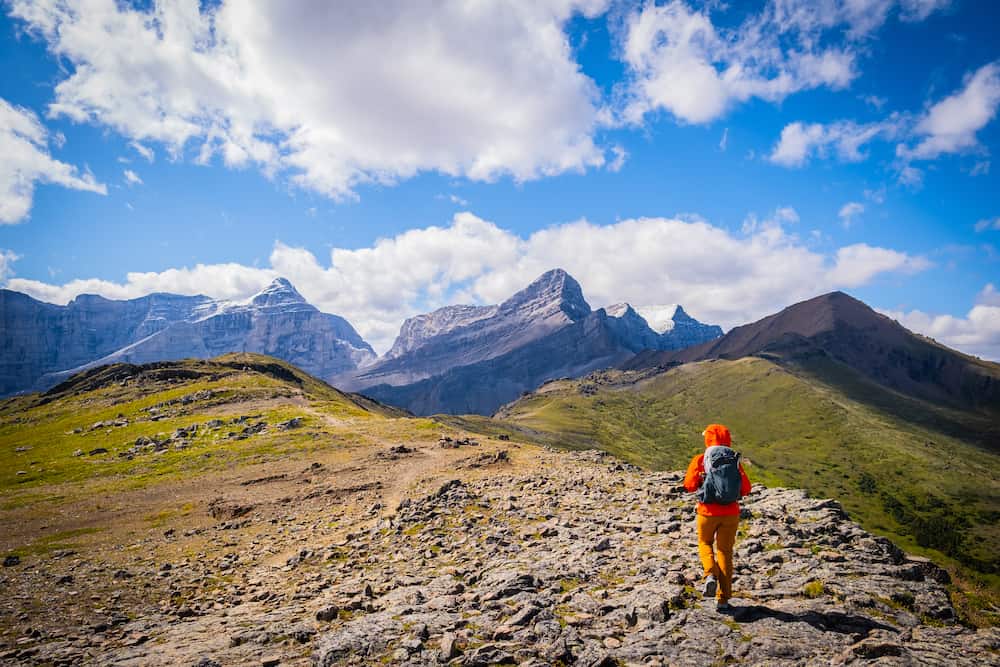
Packing right doesn’t mean overpacking your backpack. You’ll have to carry everything on your back up a mountain, so keeping your weight down is important. Pack what you think you will need and any extra items that may come in handy in an emergency. (For example, a pocket knife, first aid kit, extra energy bar, emergency blanket, and a Garmin In Reach.)
Get a Pack that Fits
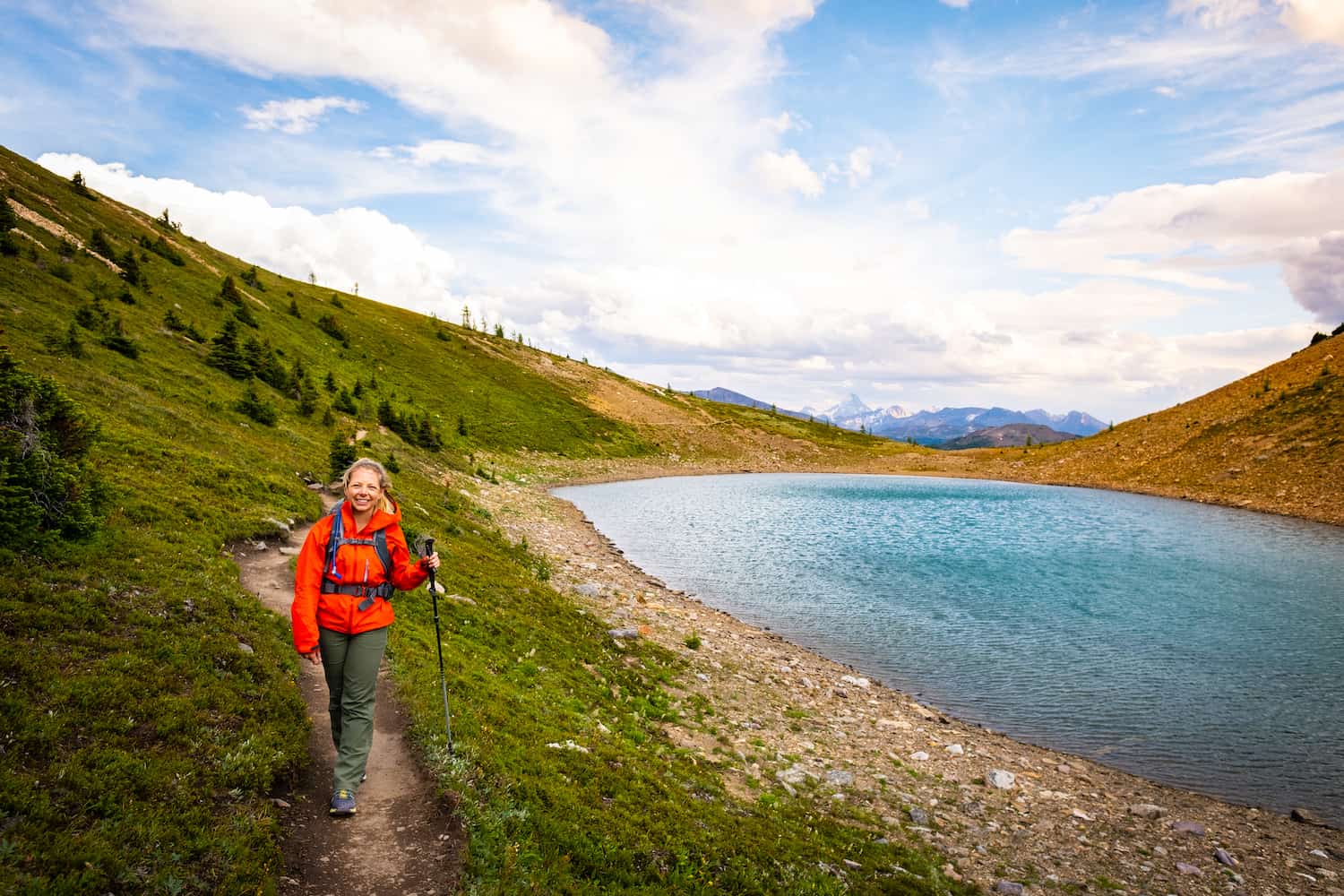
If you’re going on a backcountry trip, it’s important to pick a day pack and a hiking backpack. The backpack should fit your frame and hold everything you want to carry with you on your hike. Remember that men and women have very different frames, and they make different backpacks for each. If possible, go into the store to try on a few and find what you like before making a purchase.
Consider an inReach
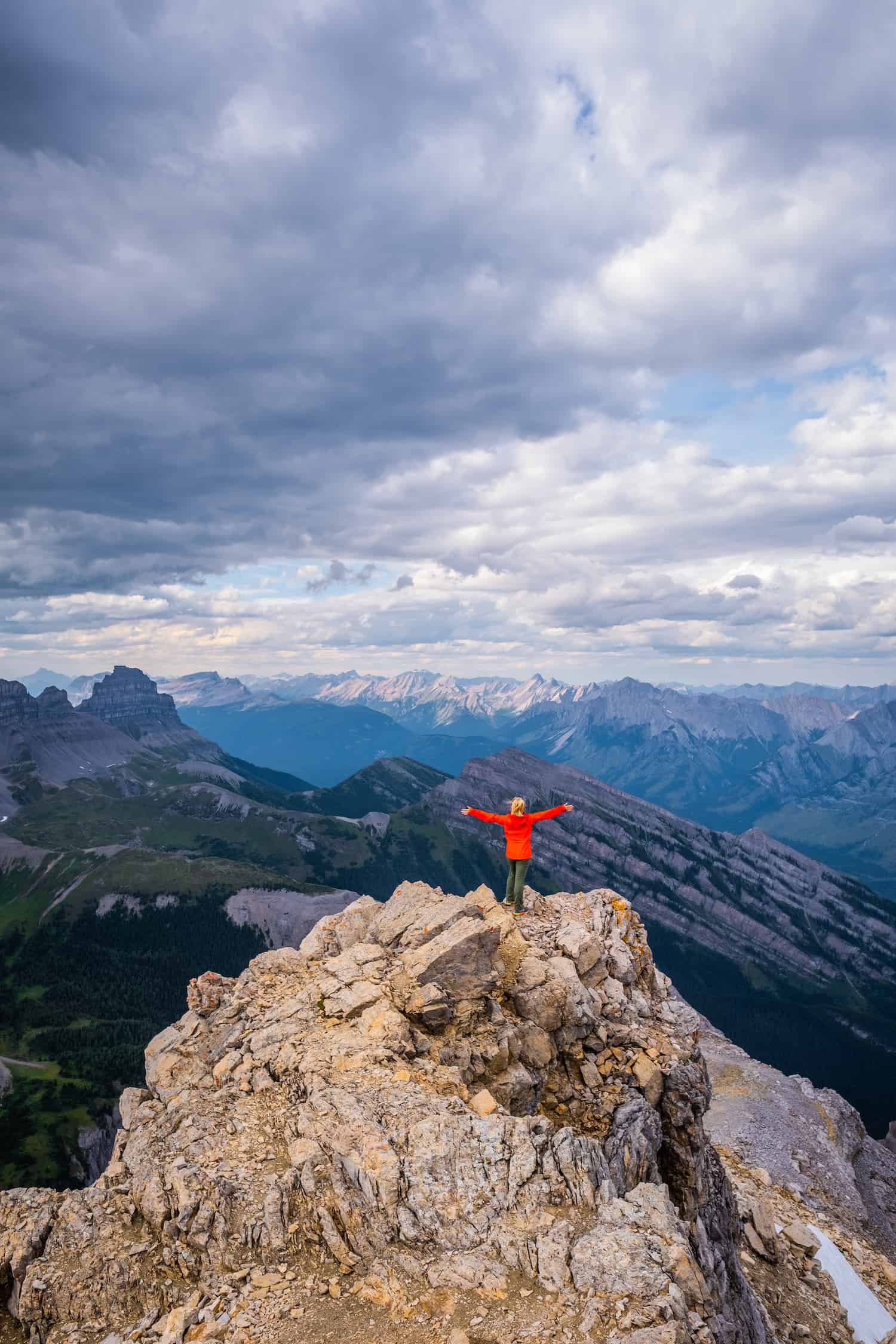
Our first year hiking in the Rockies was thankfully disaster-free. However, we were out of cell phone reception 90% of the time, and I was always worried that if something went wrong, I would not be able to call Search and Rescue. I didn’t want this fear anymore, so we invested in an In-Reach. The Garmin inReach allows us to have a GPS for navigation, keeping us safely on the trail. It’s the ultimate backpacking essential.
Then, should the worst ever happen, we have an emergency button through Inreach that notifies Search and Rescue should we ping the satellite. It’s a lifesaving device, that also does nifty features like sending short messages and even allowing friends and family to track your whereabouts when you’re on the trail. It’s expensive, but I can’t put a price on peace of mind and my life since I do a lot of hiking in the Rockies. (Psst – an InReach is also a great gift for hikers)
Pack the Appropriate Amount of Food
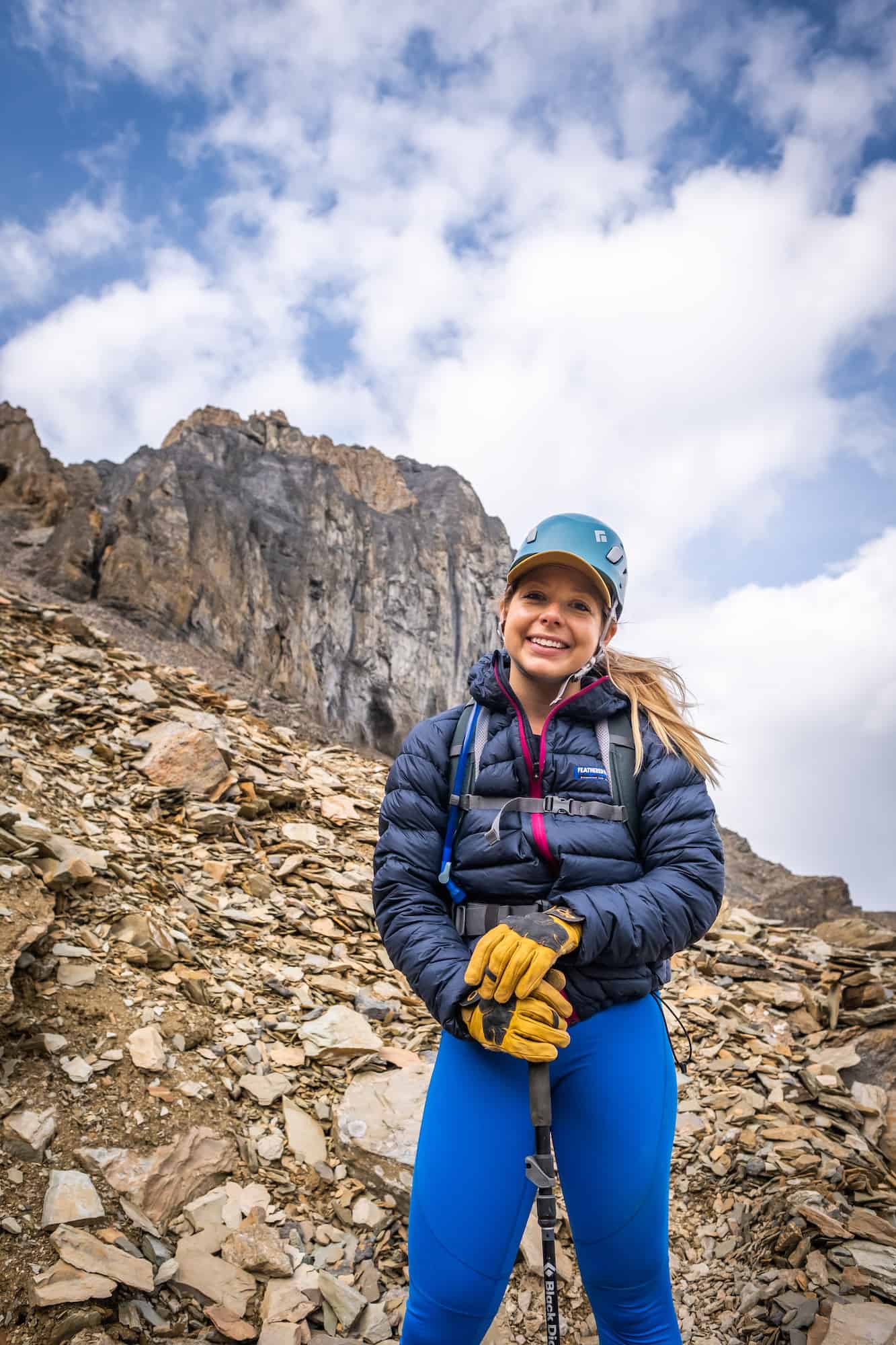
Determine how long you’ll be hiking and pack the appropriate snacks to give you energy. Plus extra, should things not go as planned. I have an energy bar, homemade energy balls, dried fruit, and some candy on almost every hike. I typically pack a sandwich and a few other odds and ends for lunch. Remember, you’ll burn more energy than usual as you’re hiking and likely be hungrier than normal.
You can hike in bear country with your lunch and snacks. Bears are not like boogeymen, ready to pounce on you at the smell of food. However, don’t leave your pack unattended with food in it, this is when animals try to get in, and it can attract unwanted furry attention.
Get Good Hiking Boots/Shoes
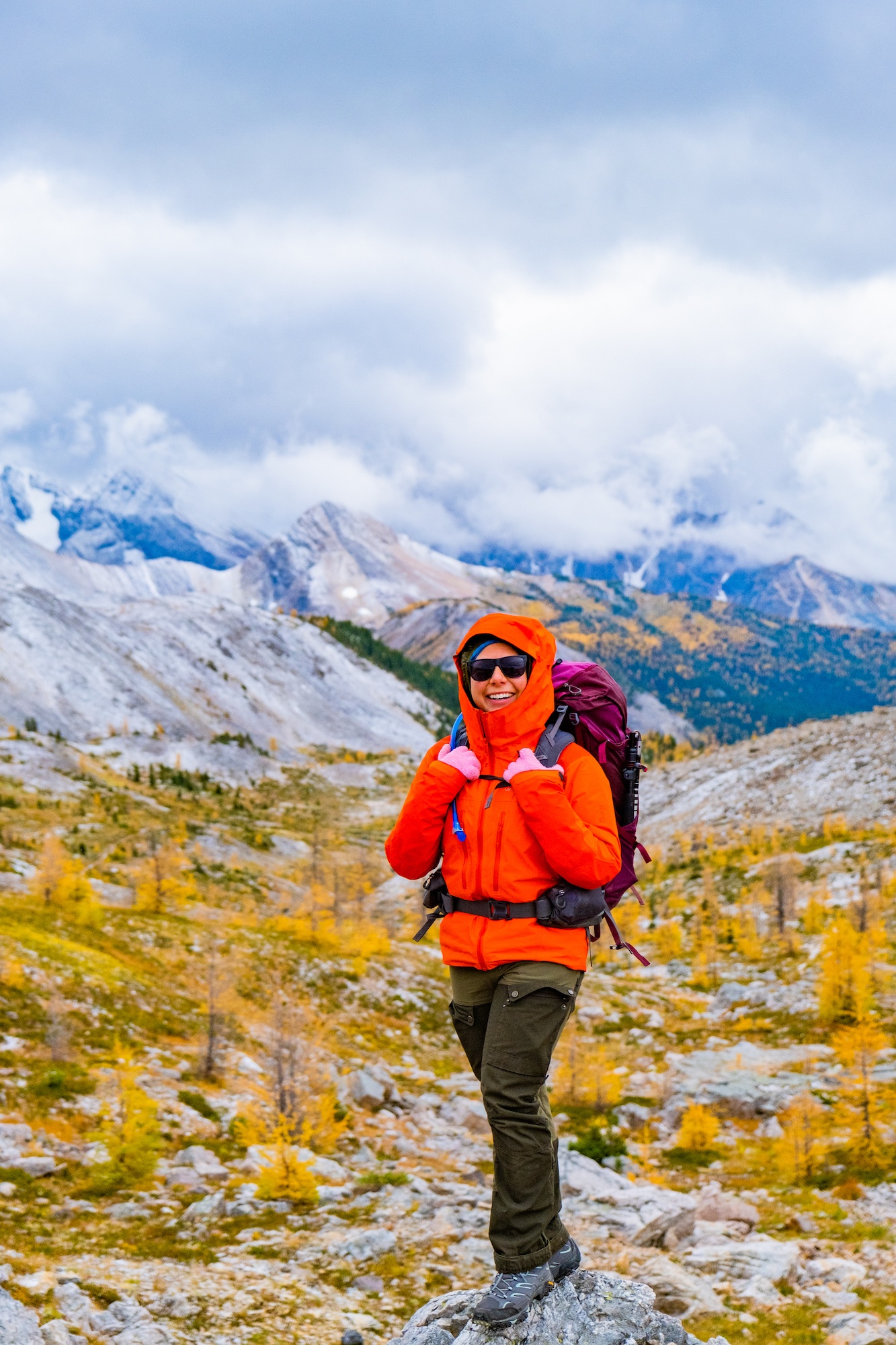
Make sure you have good hiking shoes or boots for your hike. It’s one of the most important pieces of hiking gear you have. Once your feet get tired and uncomfortable, the rest of you go quickly. Go to the store, try on a few pairs of solid hiking boots, and pay attention to their fit and comfort. We do most of our hikes in Salomon Speedcross trail runners as they are light and allow us to move quickly. If I am doing a multi-day backcountry trip, I will hike with Merrell Moab hiking boots.
Invest Later
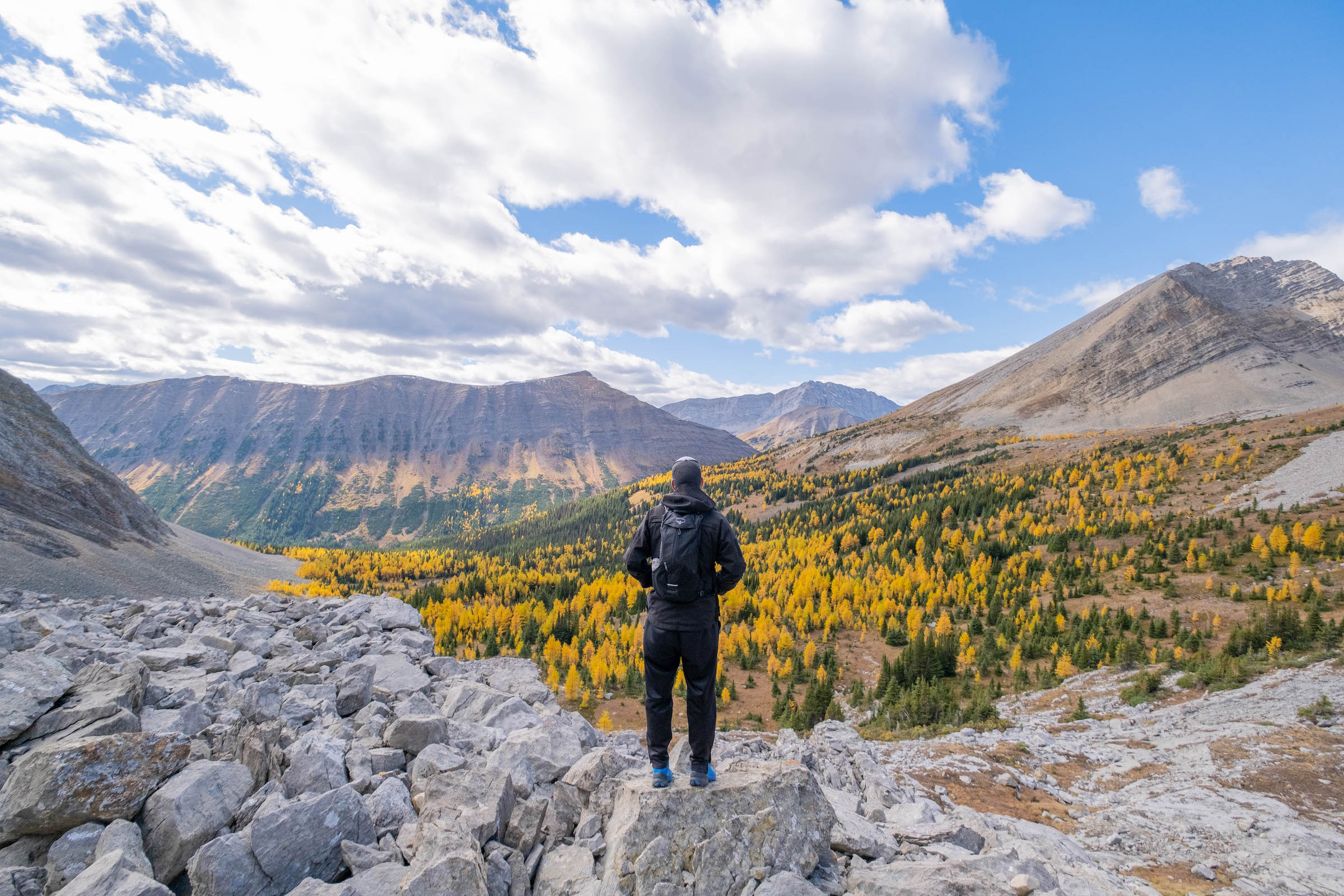
I mentioned getting a good pair of hiking shoes and a good backpack before, but other than a few hiking staples, wait on investing more money into gear. Hiking gear can get very expensive very quickly, so it’s best to figure out if you actually enjoy hiking and plan on doing it frequently before committing thousands of dollars to it. After you go on a few hikes and find out you want to spend your entire summer outside, invest in awesome socks, mid-layers, jackets, hiking poles, and more!
Avoid Hiking in Banff Alone
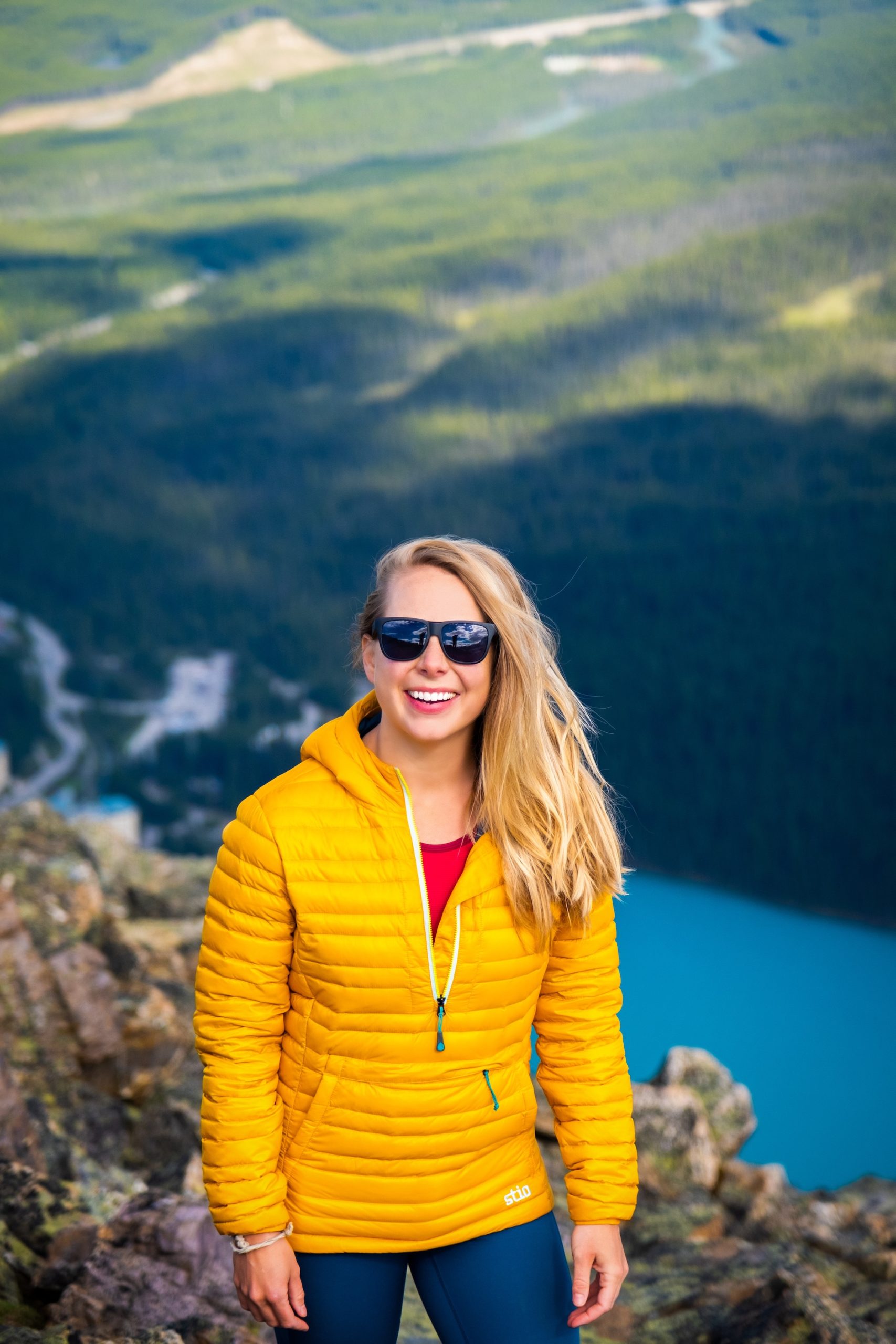
One of the best ways to stay safe hiking in Banff is by hiking with a partner. Hiking solo should be avoided by all hikers, not just new ones. But obviously, this isn’t always possible. People’s schedules don’t always line up, and you can’t wait for someone else to get into the great outdoors.
For your first few hikes, I recommend finding a friend or chatting in local groups to see if you can meet up with people. If it’s not going to happen, stick to easier, well-marked, and well-trafficked trails until you get more comfortable being in the Canadian Rockies alone.
Start Early
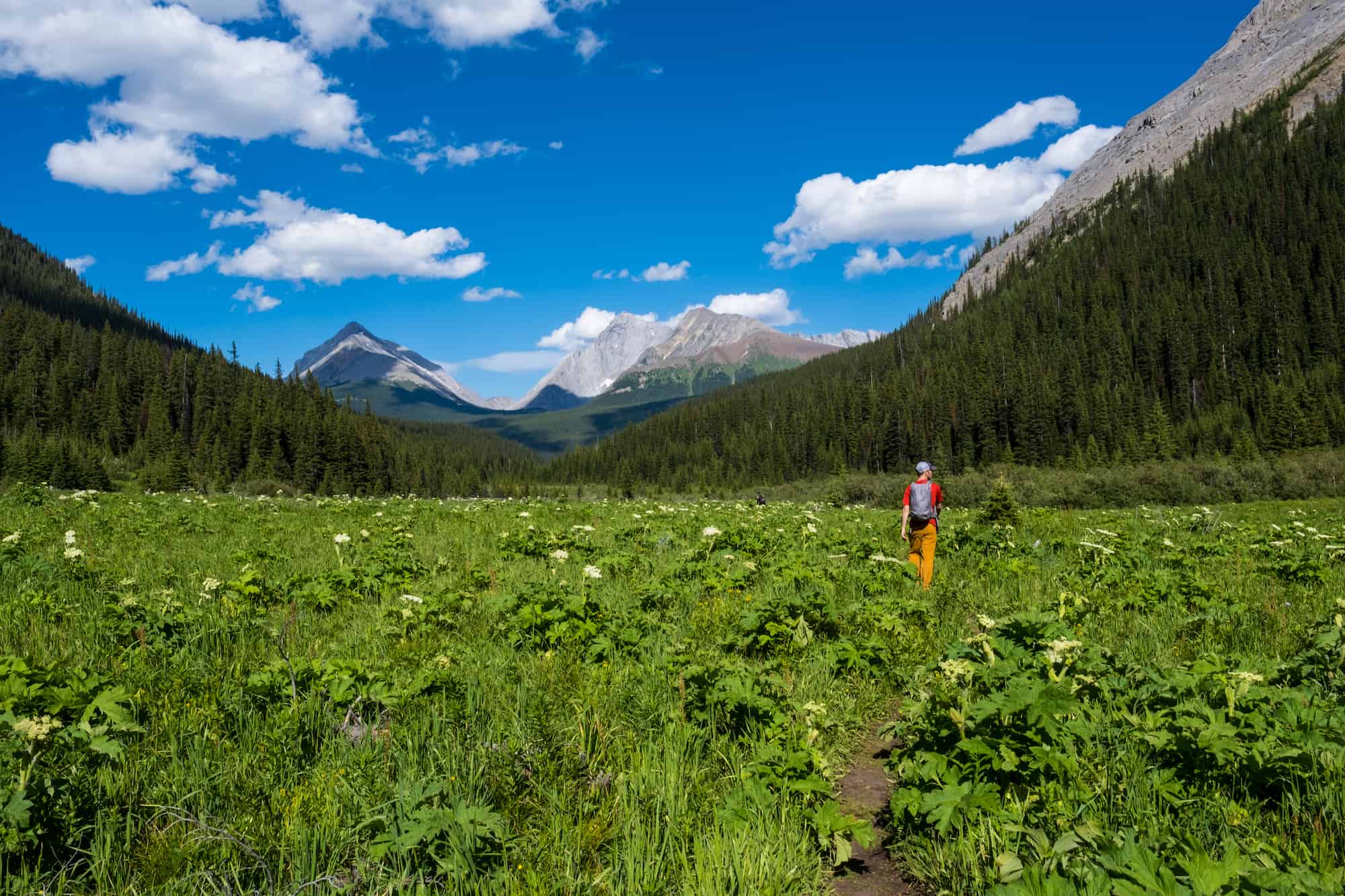
Now, we’re getting into the actual day of Banff hiking. Yay! It’s best to start early so you don’t risk hiking too late and coming off a mountain in the dark. Thankfully, the sun rises around 5am and sets around 10pm in the summertime, so you have plenty of time to explore.
Before you start out on any Banff hike, ensure you have enough time to complete the entire hike before dusk unless you intend to hike in the evening. In this case, ensure you have a headlamp in your pack and use caution.
Don’t Start Off Too Fast
A big mistake many newer hikers make is starting on the trail at a fast pace. Remember to pace yourself, especially around the Canadian Rockies, where the hike’s hardest and steepest part (the crux) often comes after a couple of hours into the hike when you are near the summit.
Pack Bear Spray (and Make Noise)
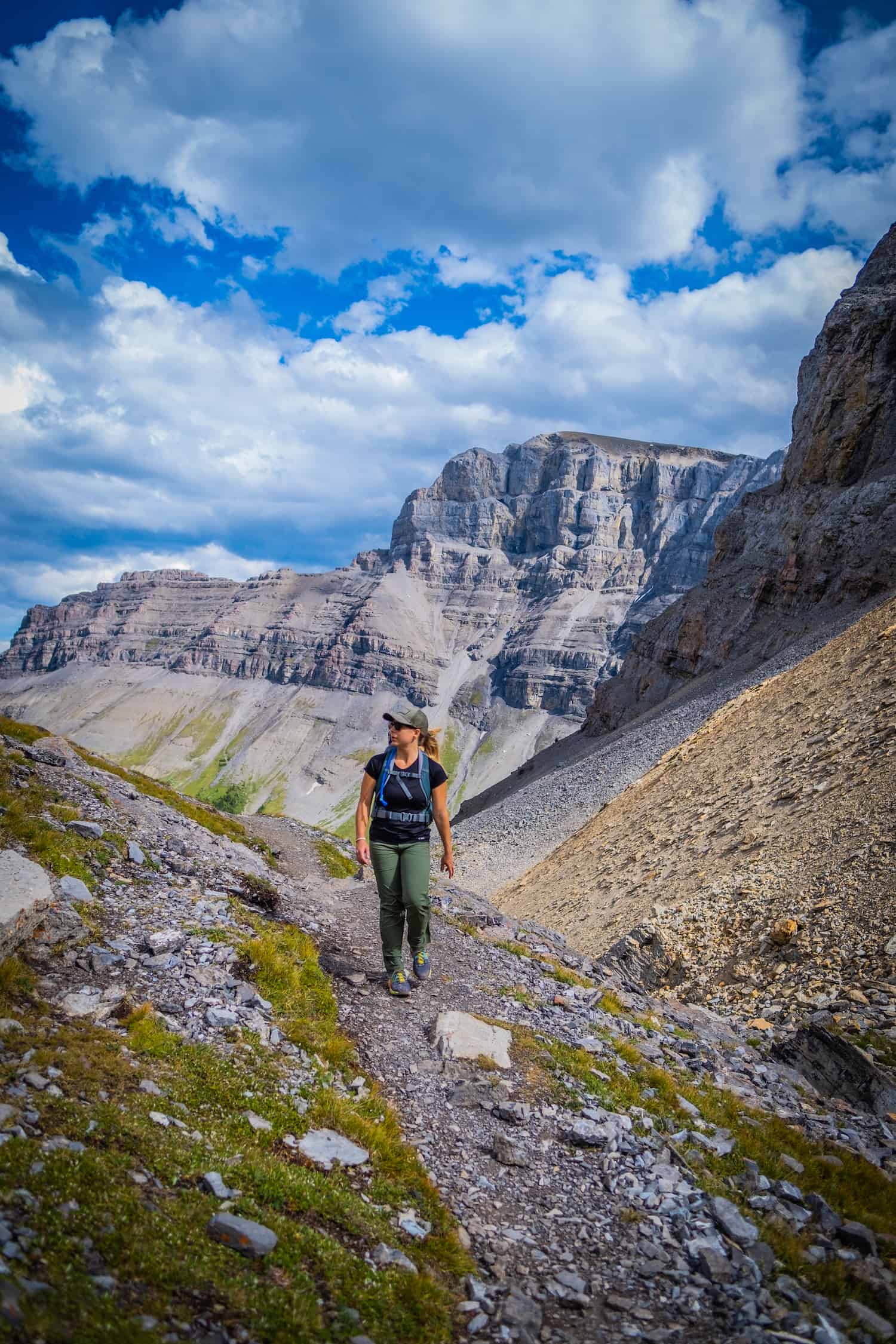
You shouldn’t hike in the Canadian Rockies without bear spray. Plenty of grizzly and black bears live in Western Canada, and while your chance of coming across one of the trails is relatively small, it does happen. No, a bell will not save you, and neither is a boom box should this happen.
Your only defense against a bear in the woods is bear spray. Which is essentially pepper spray for bears. You can pick up bear spray at all outdoor shops in Canmore or Banff for around $50. I like Atmosphere in Banff and Valhalla in Canmore.
(PS) Remember, bear spray doesn’t do any good if it’s at the bottom of your backpack. A bear isn’t going to wait on you to dig through your stuff and pull it out in the wild just for you to spray it. Keep it accessible.
Don’t Forget Sunscreen
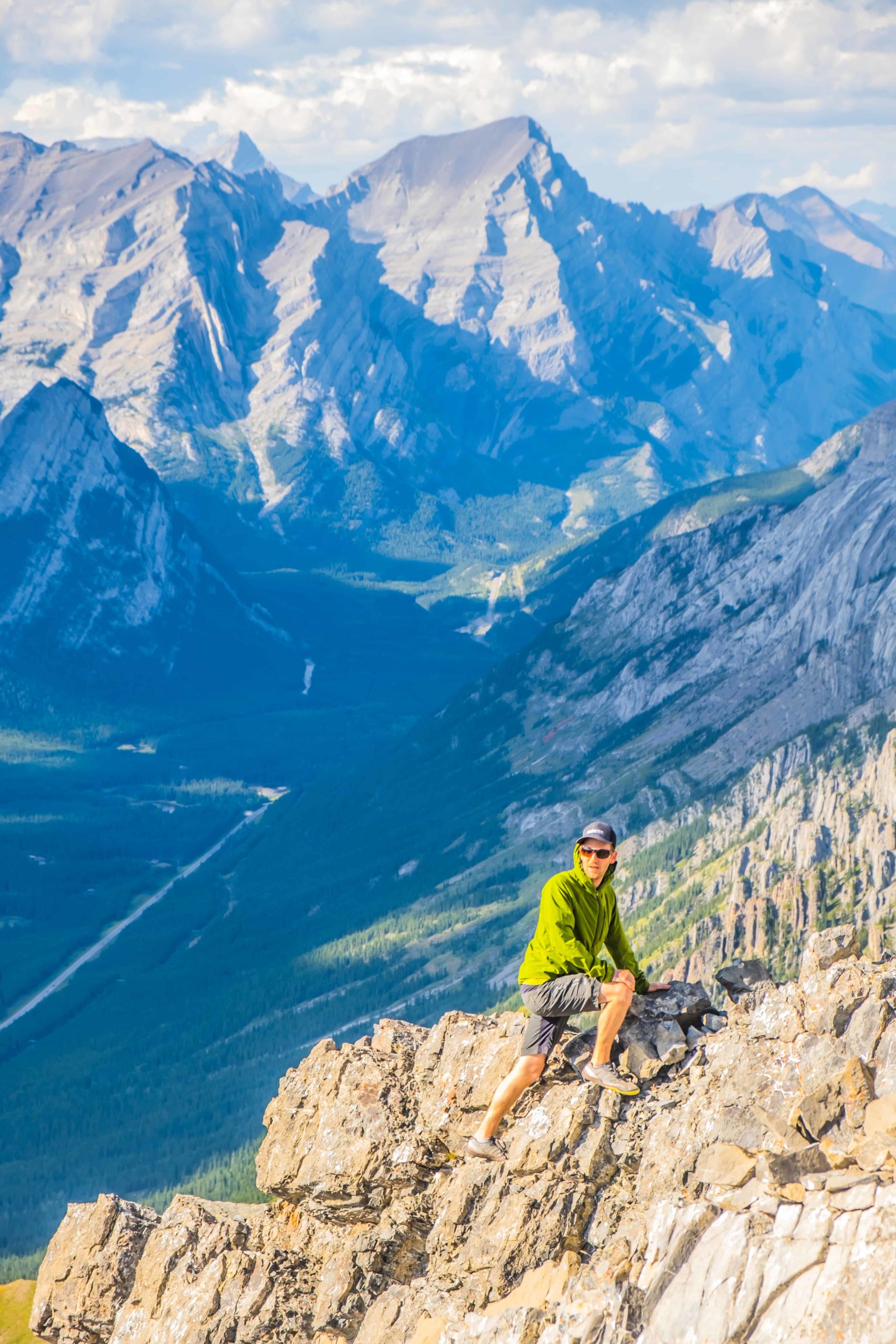
Just because it doesn’t feel hot in Canada does not mean the sun is not shining. Before setting out, wear sunscreen on your arms, legs, face, and neck. And don’t forget behind the ears! It often gets overlooked.
Stretch and Prepare
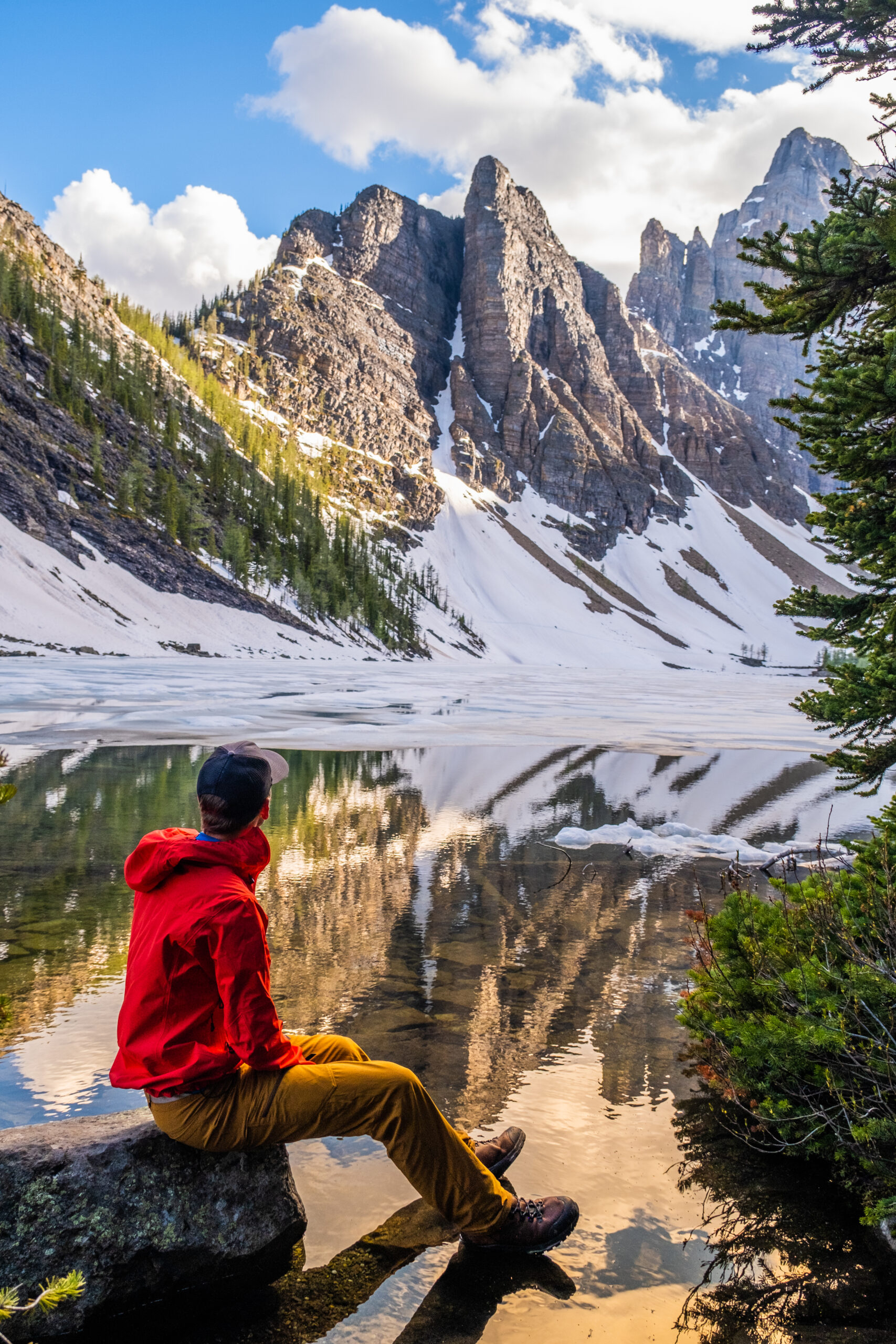
Before you start your Banff hikes, take some time to stretch out your quads, calves, and other muscles. You’ll be working them hard soon!
Don’t Shortcut Switchback Trails
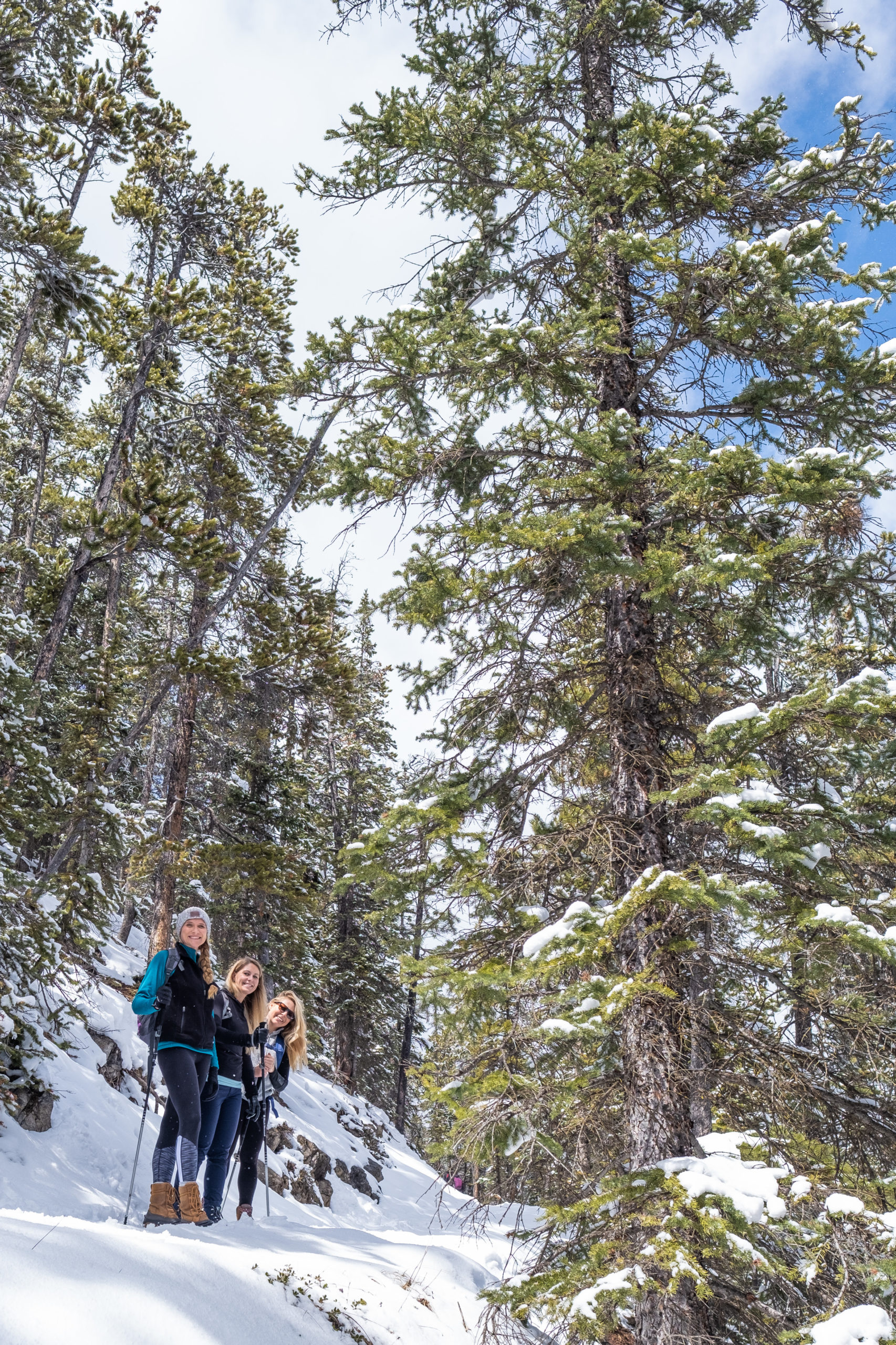
When you’re on a well-marked switchback trail, don’t cut them. It’s something I see quite often from newer hikers and should be avoided. Switchback trails, especially maintained ones, were made like that for a reason. Not only can it be unsafe to cut them, but it can also cause damage to the ecosystem off the trail, leading to future erosion. Please stay on the trail.
Don’t Feed the Wildlife

Do not feed the wildlife anywhere in the Canadian Rockies. Don’t feed the chipmunks, don’t feed the squirrels, don’t feed the elk, don’t feed the birds, and for the love of God, don’t feed a bear. Not only is human food not part of an animal’s diet, but feeding them actually puts them in danger. When park visitors feed animals, intentionally or not, it brings them closer to populated spots and can cause human-wildlife interactions, which typically turn out much worse for the animal.
Leave No Trace
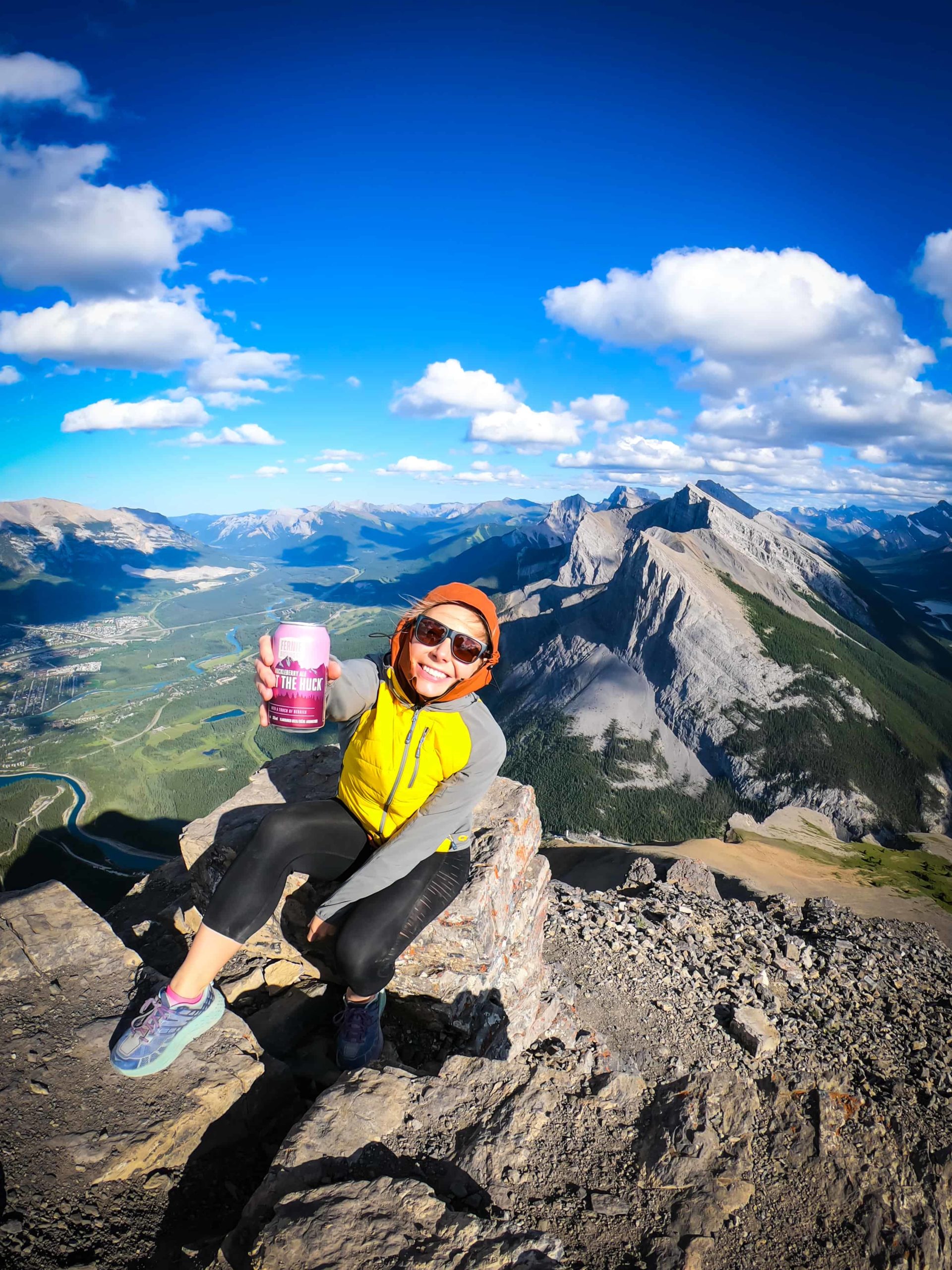
On that note, I must always practice Leave No Trace principles. Always leave the wild the same or better than you found it. Clean up after yourself, pick up your trash, pick up other people’s trash, don’t disturb the wildlife, don’t build pointless rock cairns, don’t paint rocks and leave them in the wilderness, and don’t pick the flowers in Banff! A big no-no.
Stay on the Trail
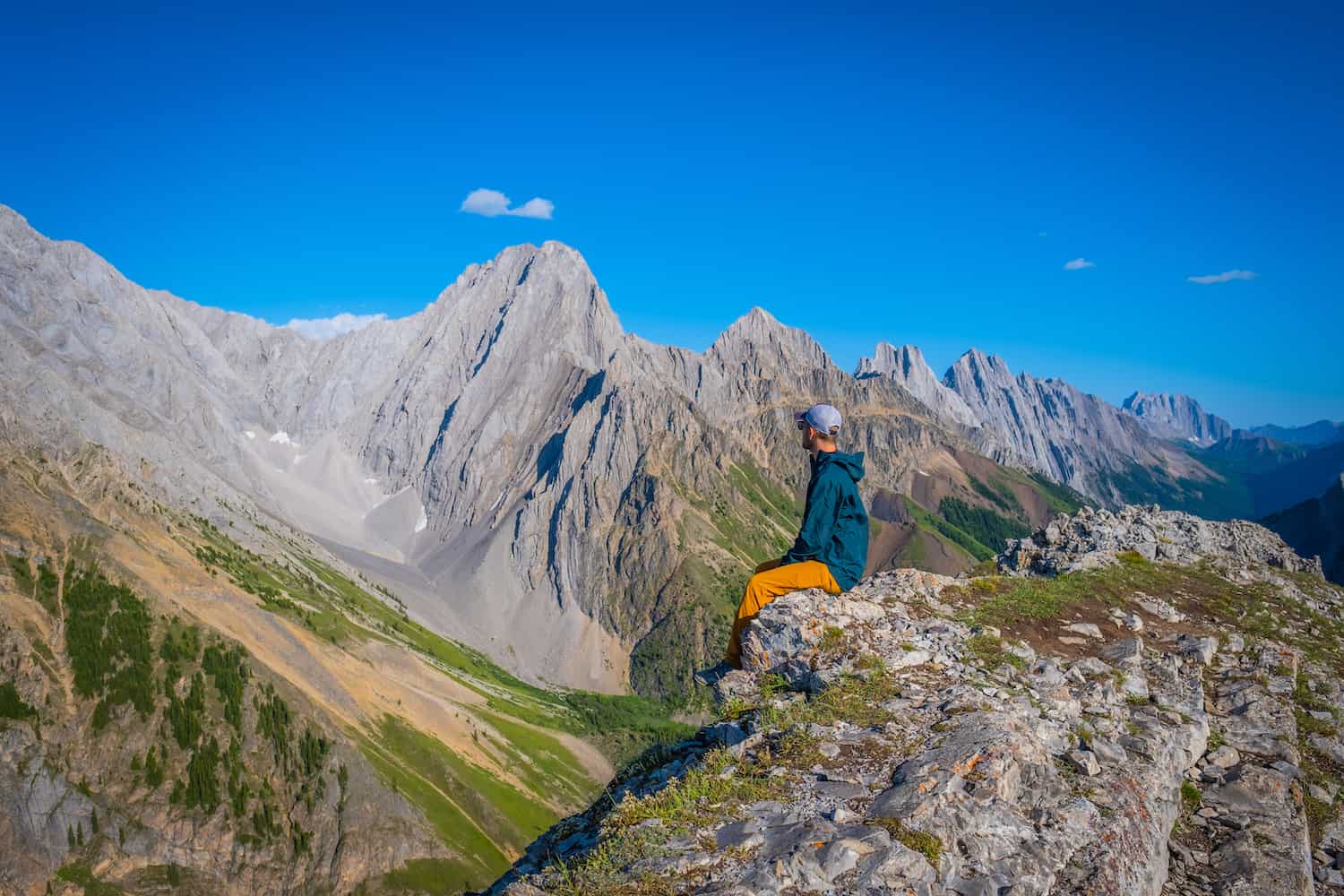
The best way to not get lost in the wilderness is to stay on the trail. This can be tough if you are really off the grid, but most beginner hikes around Banff are well-marked enough to keep you on the right course.
Respect Everyone
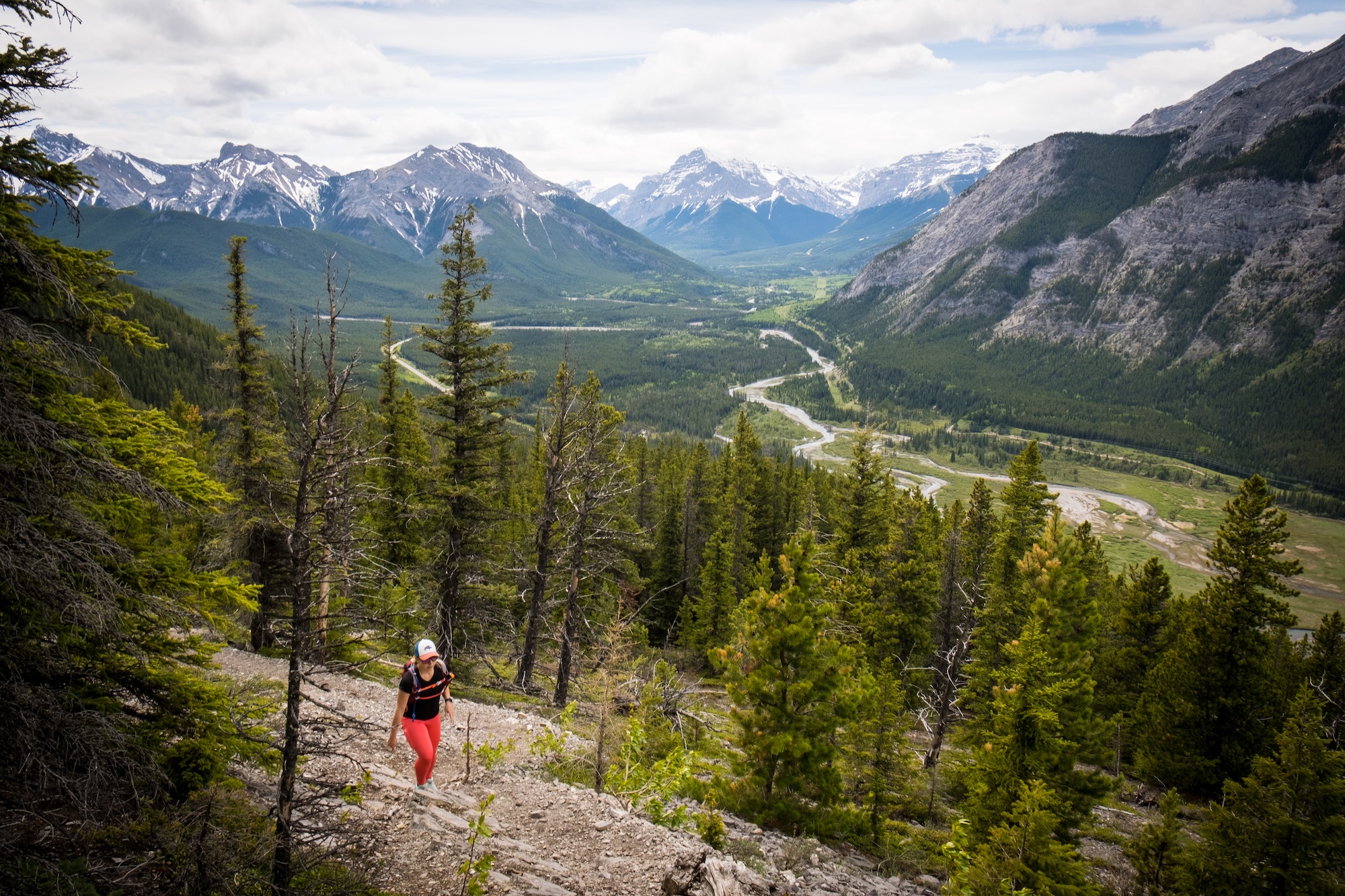
Always respect other hikers when on the trail. Give people their space, say hello to passersby, let faster hikers pass you, and don’t blast loud music on the trail. Remember that proper hiking etiquette is to let the ascenders pass you as you descend. Uphill hikers have the hiker right away. That means if you are coming off the mountain and encountering hikers climbing up on a narrow trail, move to the side and let them pass.
Stay Hydrated
It’s important to bring enough water with you on your hike. I typically start with 2 Liters and will adjust accordingly to my objective and anticipated hiking time, but I drink like a camel when I hike.
You can pack your water in a water bottle or bladder. I personally love hiking with a bladder so that my water is always accessible without having to slow down and stop for water breaks with a water bottle.
Know Your Limits
Lastly, know your limits when you’re hiking in Banff and stick to your objective. You don’t get any rewards for pushing yourself further than your body can handle on the trail. Don’t summit one mountain and think you can for another if you physically can’t. The mountains here will humble you – truly.
One of my favorite mountain quotes is by Hermann Buhl. As he says “The mountains have a way of dealing with overconfidence.” Don’t let your ego get in the way of your safety.
It’s Natural to Have Fears of Hiking in Banff
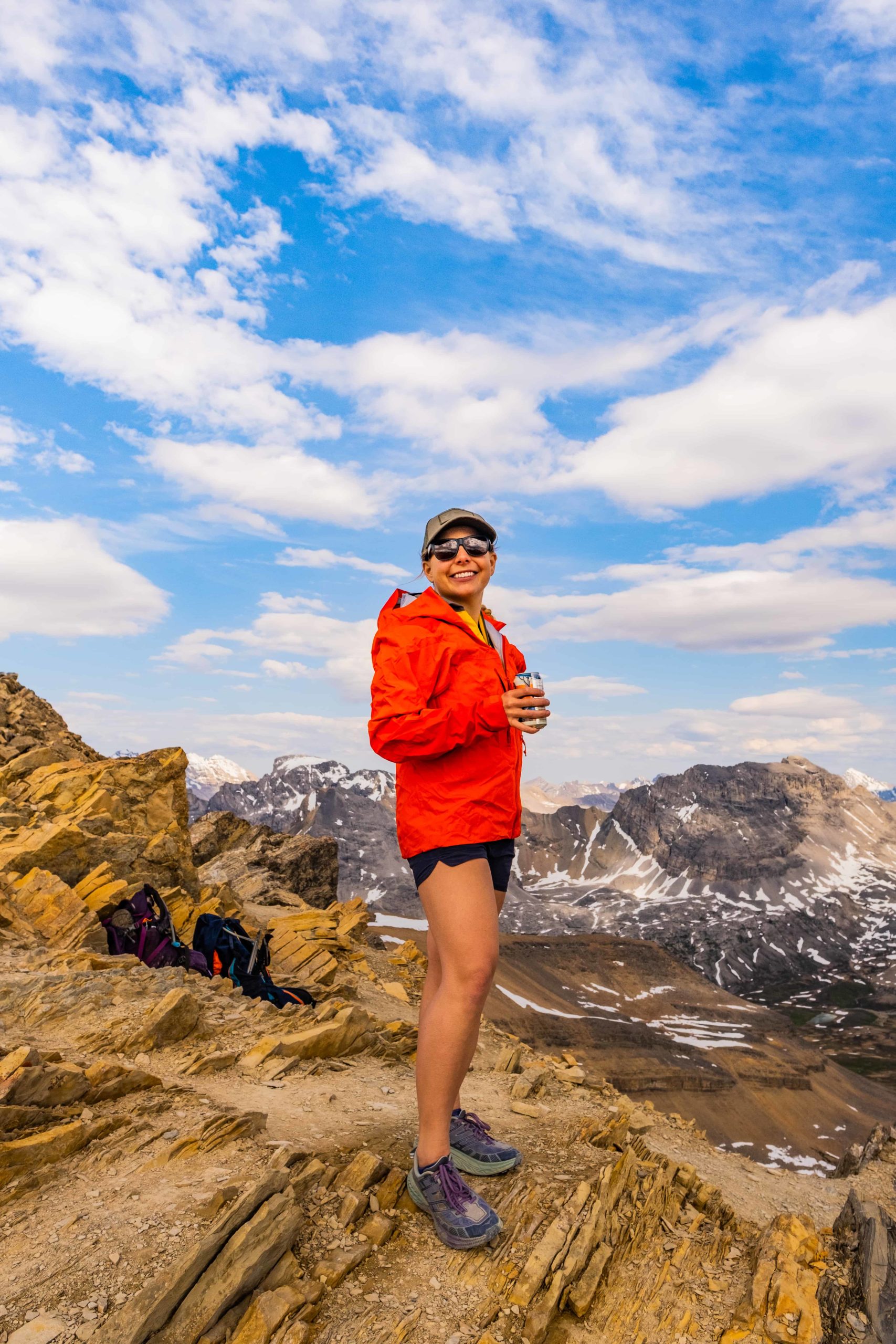
It’s okay to be intimidated your first time hiking, especially in Banff where the mountains are so high and right in your face. Nature can throw a lot at you whether it’s wildlife, weather, elevation, and then there are your own personal fears like getting lost and mental and physical ability.
One of my top pieces of advice is to keep a good attitude and don’t let one bad experience scare you. Don’t let an overactive brain and negative thinking hinder you. Remember, if something ever doesn’t feel right, it’s okay to turn around!
Wildlife Encounters in Banff
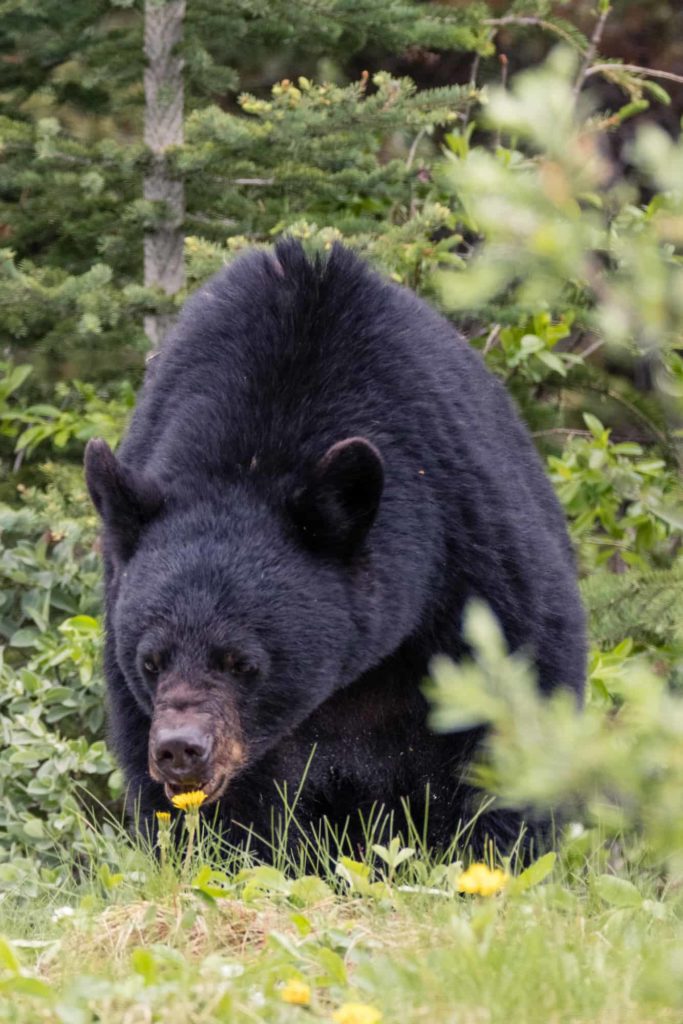
Wildlife encounters are not something only newer hikers have to deal with. Everyone should be prepared to encounter wildlife in Banff. One should never go out without bear spray.
And each person in the group should have their own bear spray, don’t rely on one bear spray for multiple people. Other hiking tips to help you with wildlife encounters are to:
- Try not to hike alone. Having just one other person to talk to and make noise with will deter animals.
- Stick to popular hiking times like peak summer on a weekend if you are alone. Popular Banff trails rarely have wildlife on them.
- I don’t like music blasters, but if you are alone listening to a podcast while hiking will create the ambiance of a group. Don’t use headphones, then you can’t hear what is going on around you.
- Be on the lookout for fresh animal tracks and droppings.
- Most wildlife wants to avoid humans, keep that in mind.
- If you come across a bear don’t run. Remain calm and let the bear know you are there by talking and backing away slowly. In the very rare case, the bear chargers utilize your bear spray.
- Your bear spray should always be accessible and able to be reached within 2 seconds. Having bear spray at the bottom of your pack is pretty much the same as not having it at all.
- Let Parks Canada know of any rare sightings like wolves, bears, or cougars.
- If you’re hiking with a dog keep it leashed. This is for the pets safety and the wildlife. Also, it’s against bylaw to have your dogs off-leash in the Bow Valley.
Our Tips For Hiking In Bear Country
↓ Join the community ↓
The Banff Blog Facebook Group is your headquarters for Canadian Rockies travel advice and information, including hike and off-season travel information. You can also meet new adventure buddies.
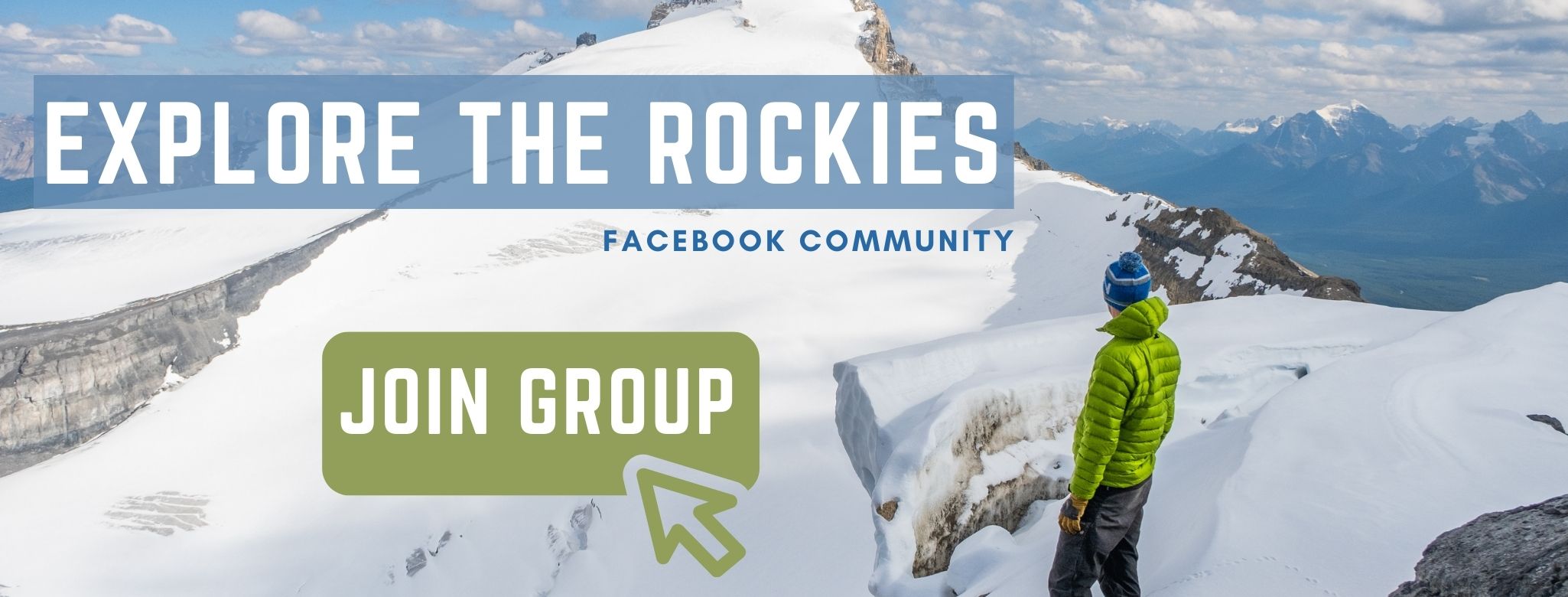
Plan Your Trip to the Canadian Rockies
- Tours (New in 2024): The Banff Blog is partnering with one of the leading tour companies in Western Canada so readers can experience the magic of the Rockies with other travelers – without having to think about a thing. See all our 2024 tour offerings here!
- Hotels in the Rockies: There are many places to stay, from luxury hotels to wilderness cabins. See all our favorites here.
- Get to Banff or Canmore Without a Car: The Banff Airporter provides fantastic service connecting you from the Calgary International Airport (YYC) to Banff or Canmore.
- Get Around: We suggest renting a car to get around. You can search for rental cars on Rentalcars.com. Or embark on an epic campervan trip. We like to compare prices on Motorhome Republic and Outdoorsy.
- Cheaper Airfare: We also use Going to watch for cheap airfare deals!
- Hop On, Hop Off: This tour is taking Banff by storm. It’s exactly what it sounds like, hop on and off a bus bound for all the best attractions at your own pace!
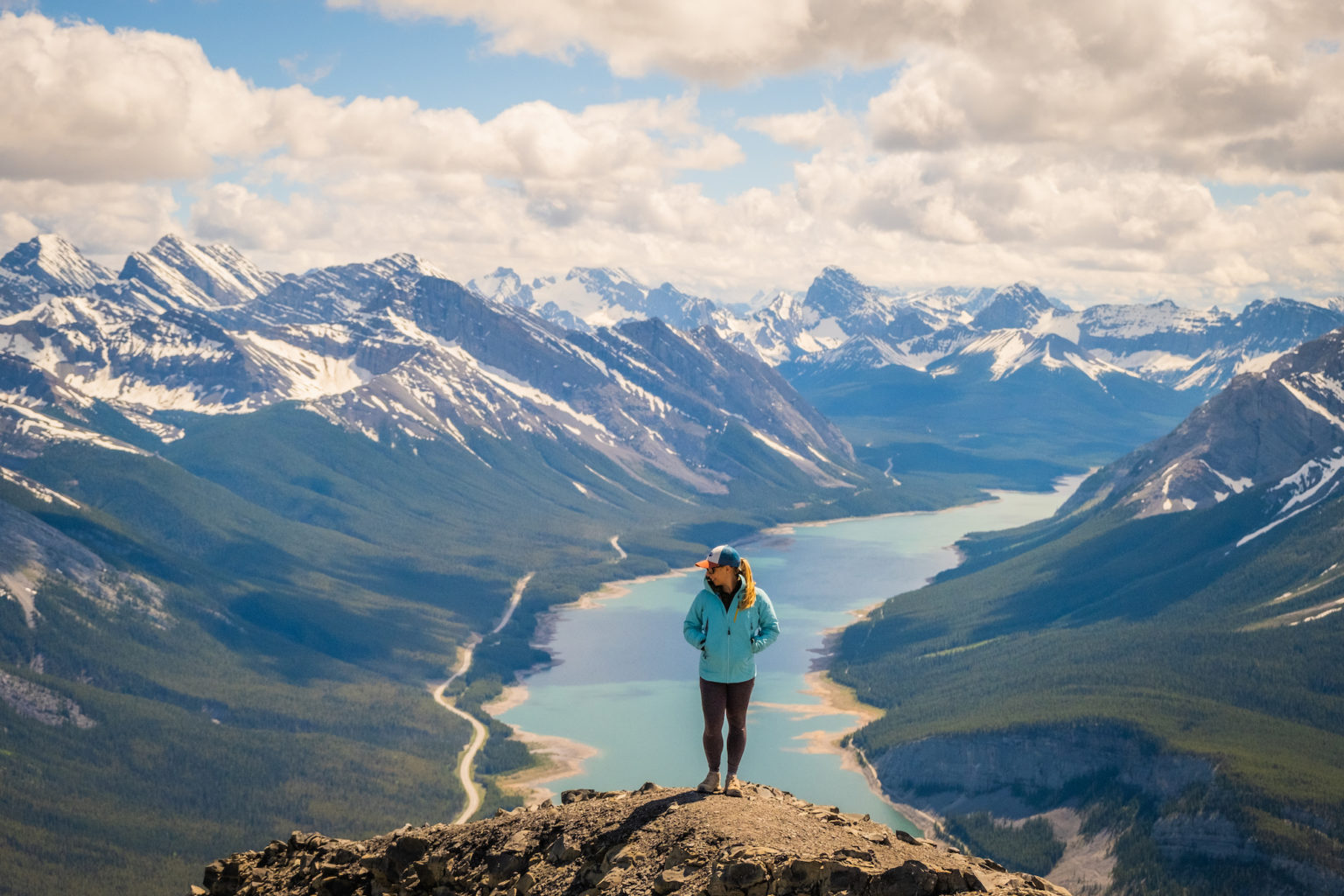
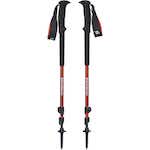
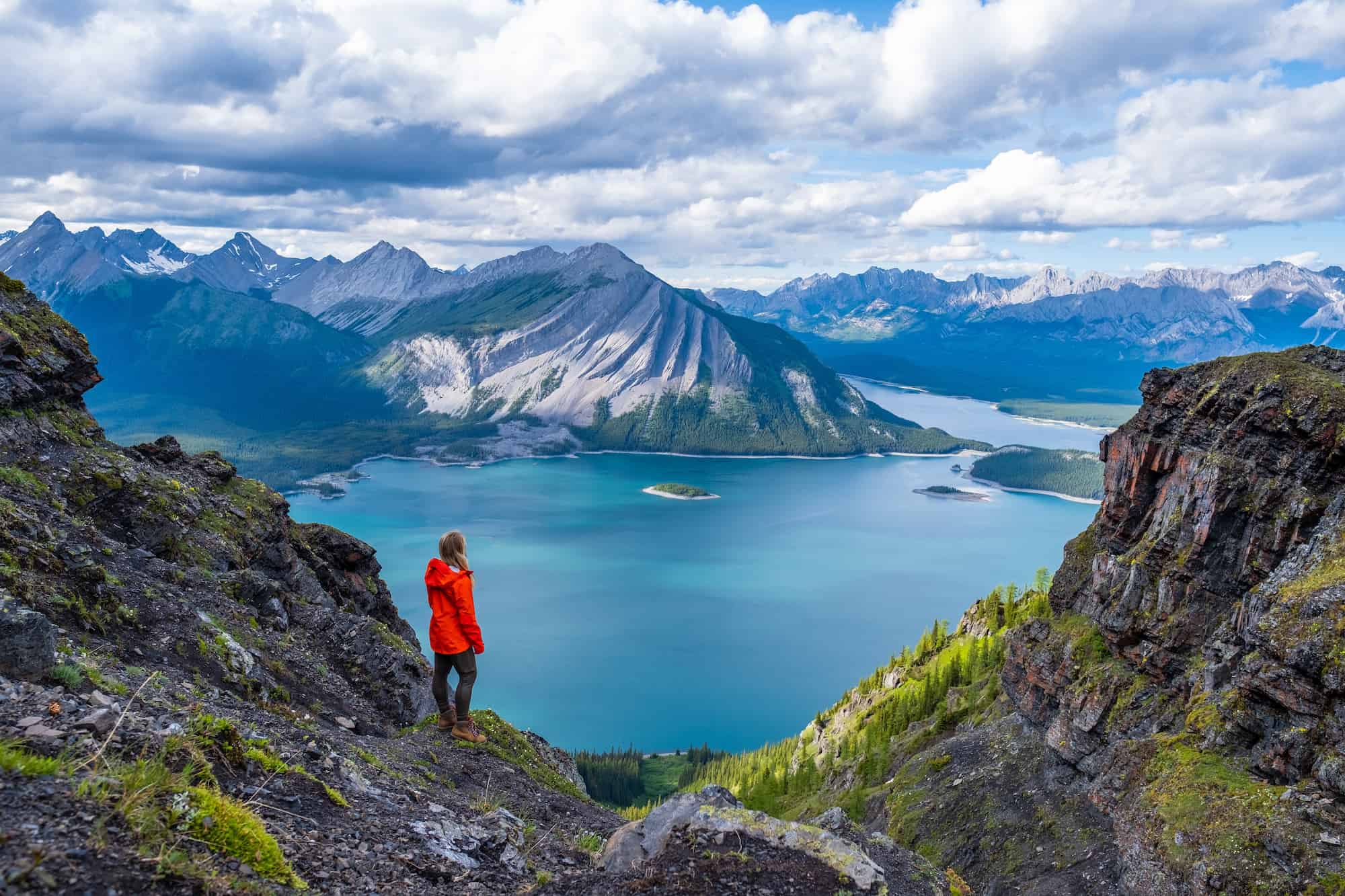
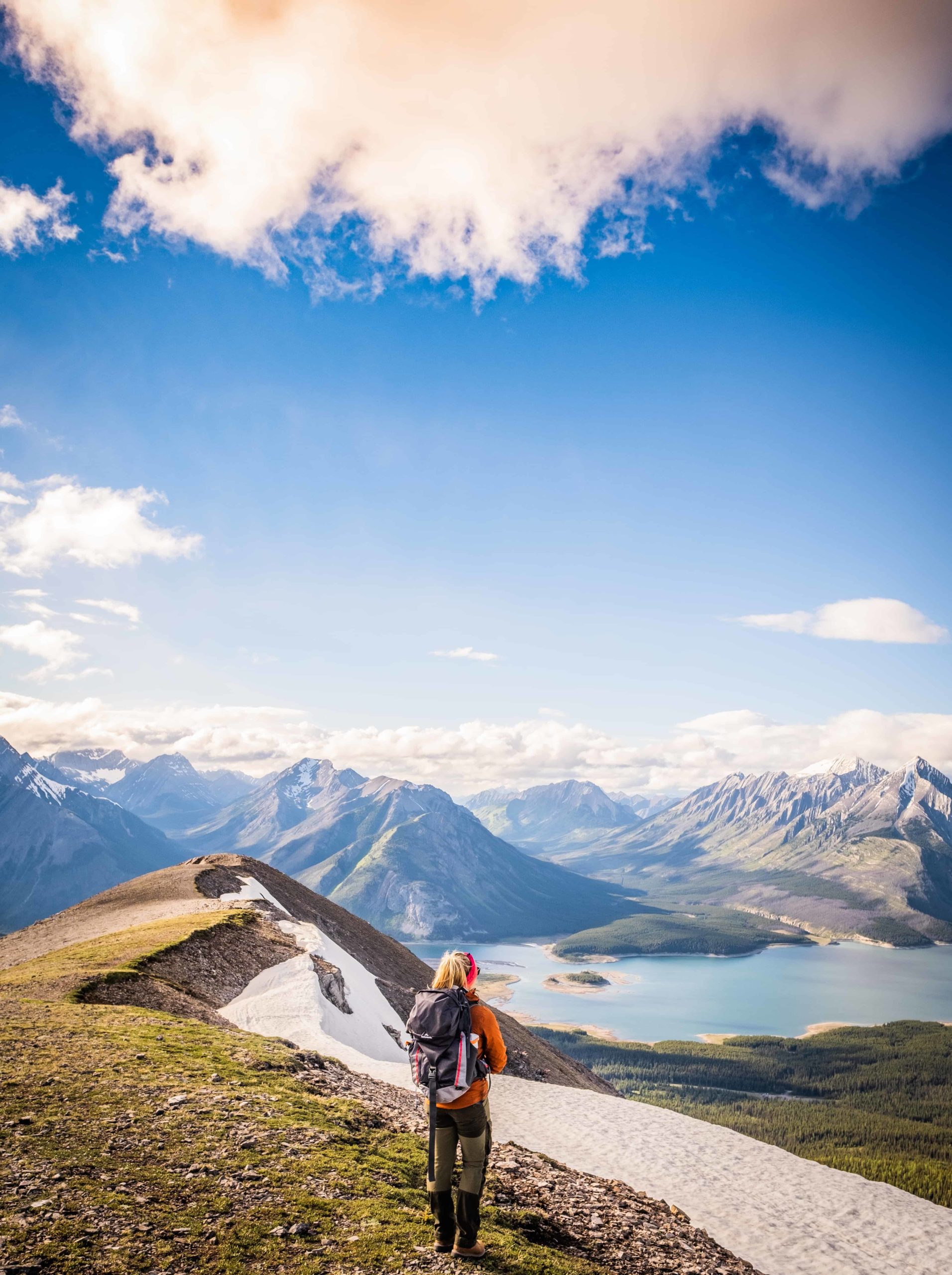
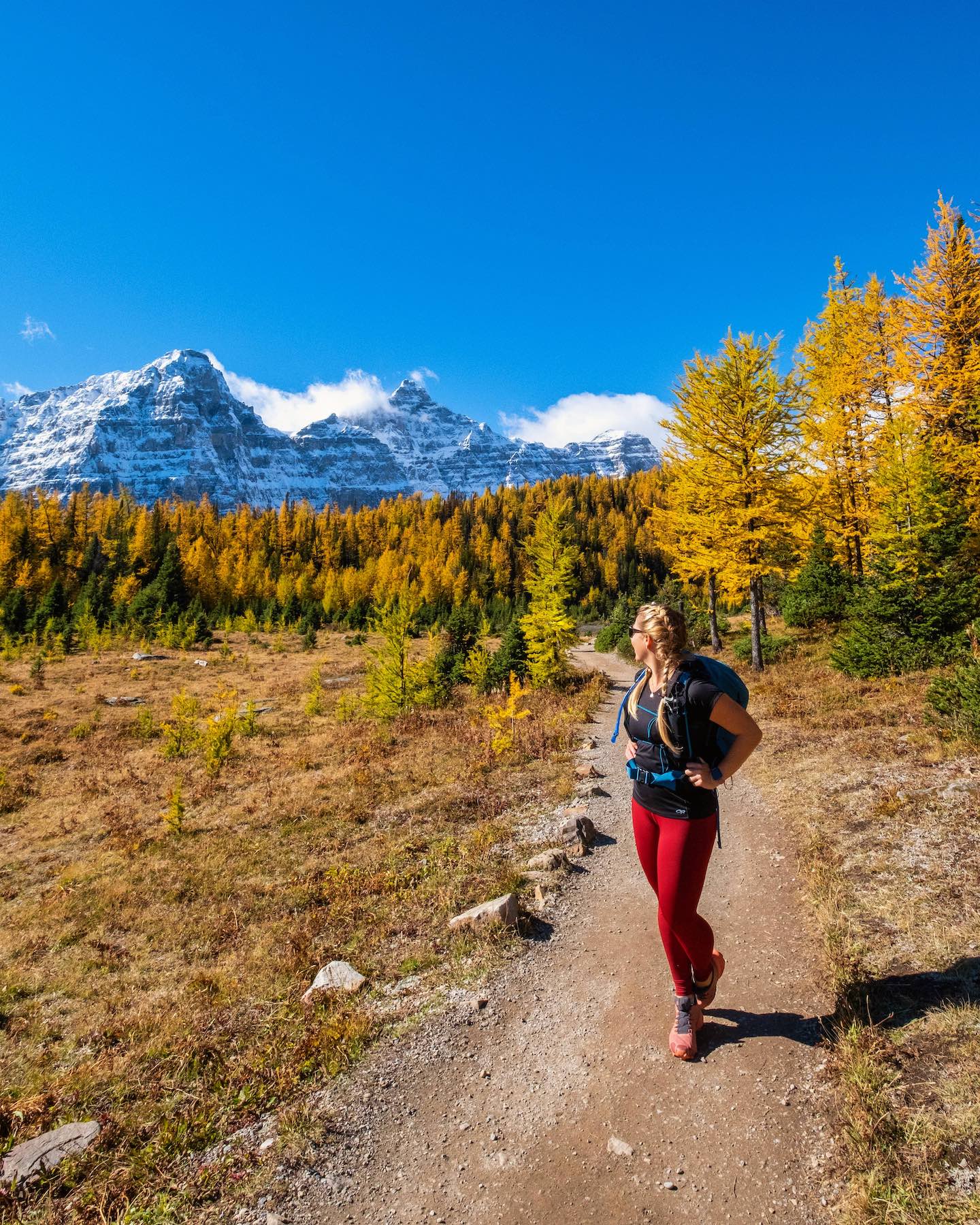
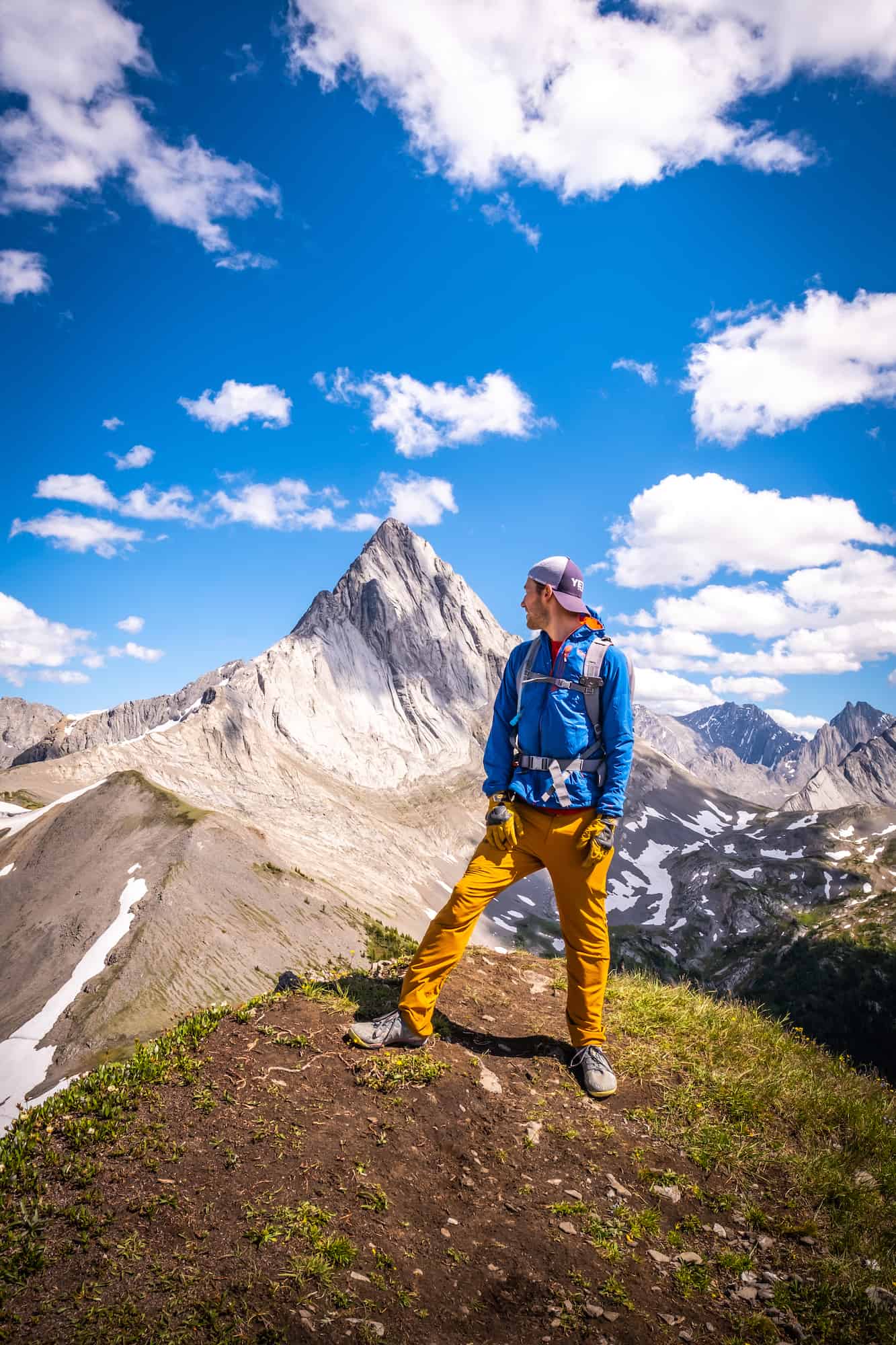
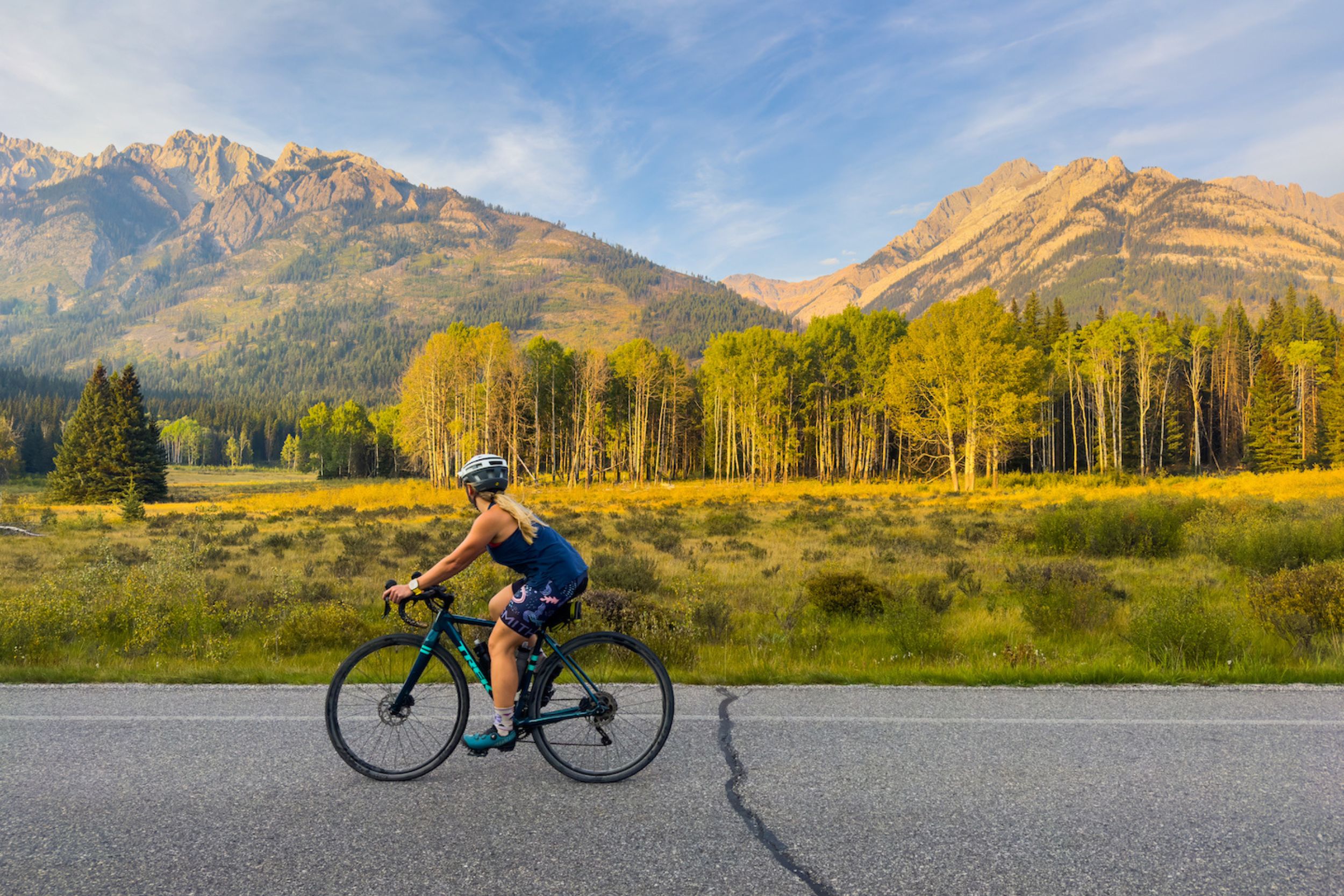
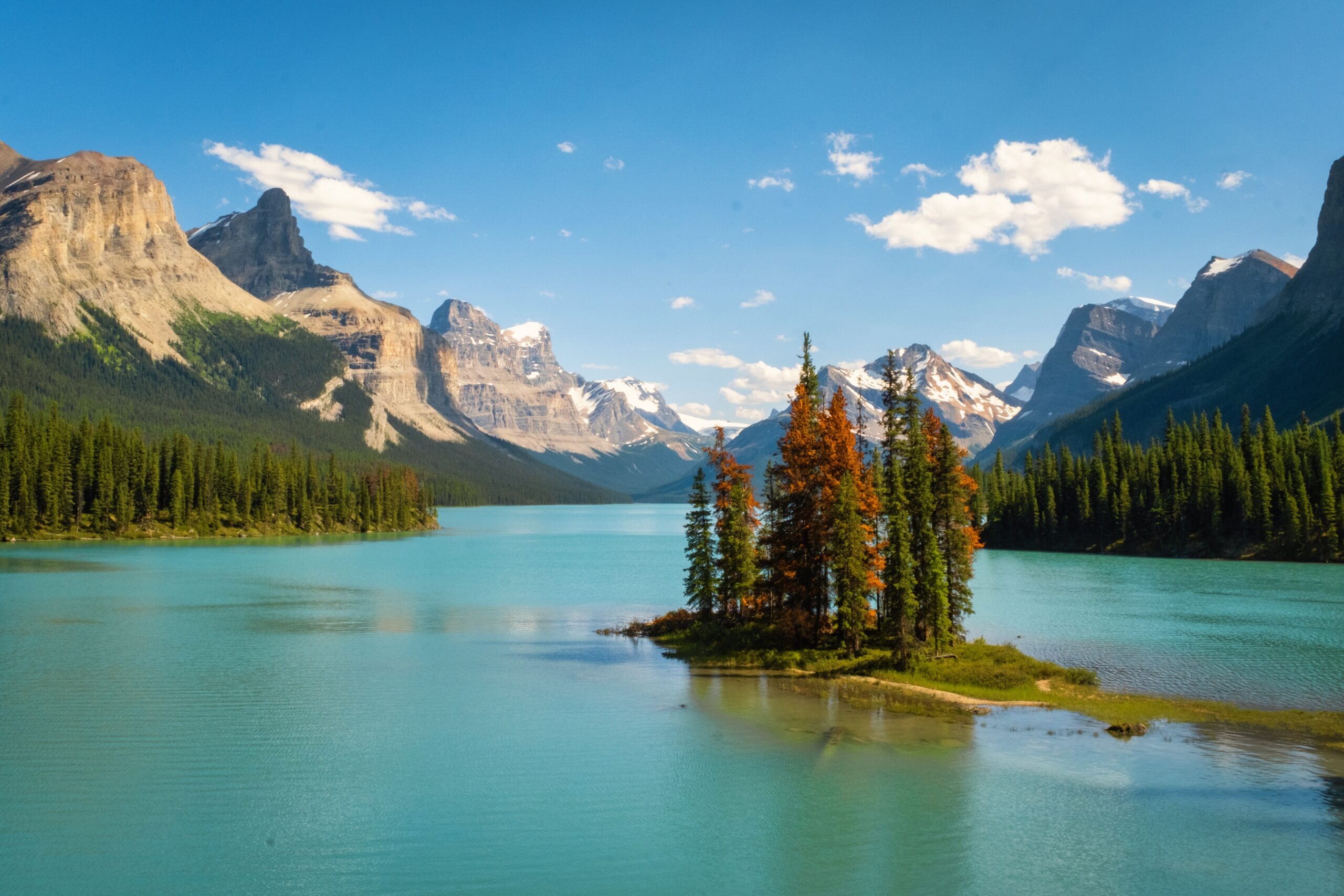
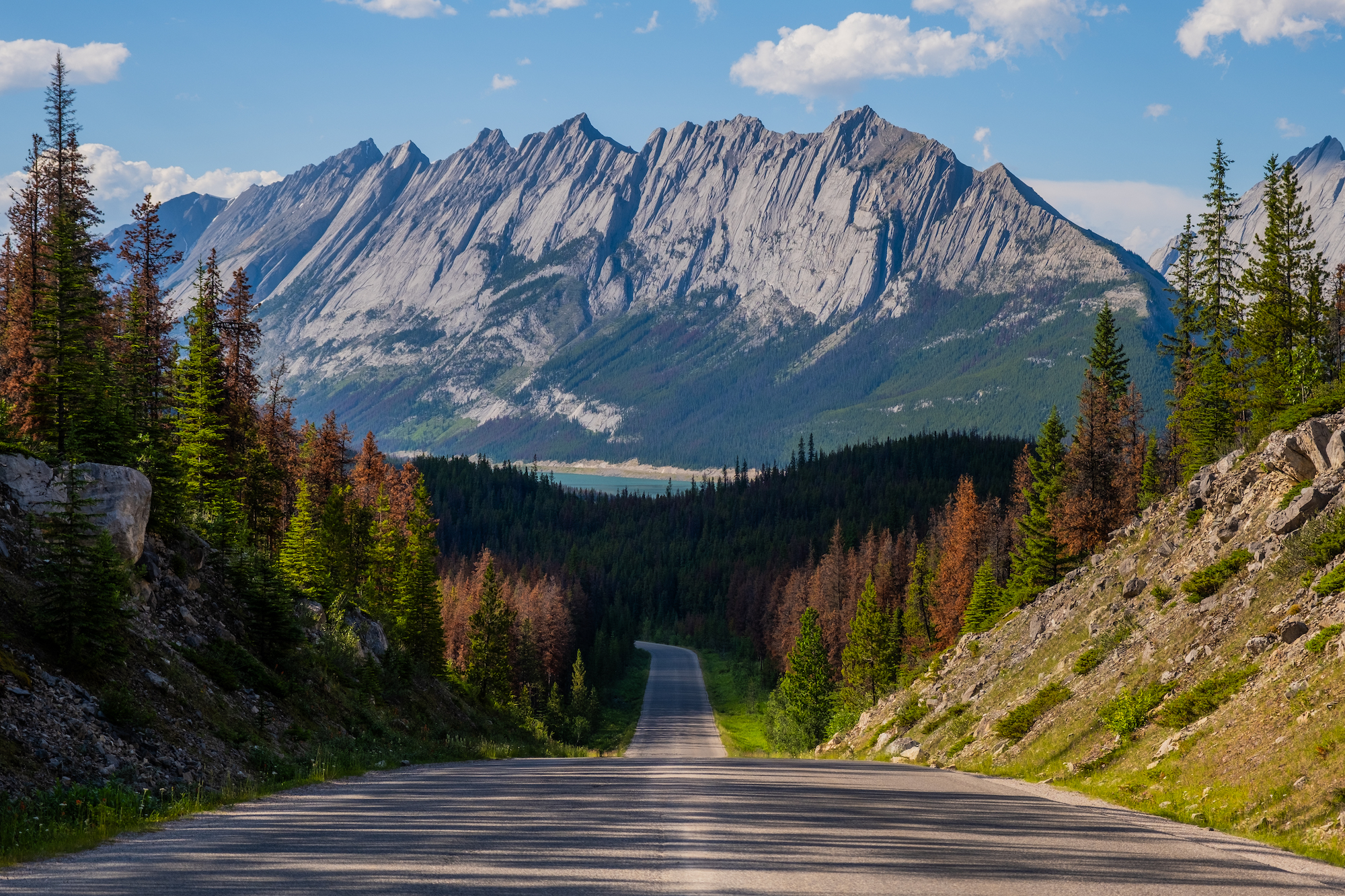
Is a Bluetooth speaker good for making noise? I’ve seen groups coming by playing music but it doesn’t seem too loud.
It certainly makes noise and sounds like a human, probably better than a bear bell. However, I find it a tad obnoxious and don’t go hiking to listen to music.
What a beautiful pictures. So colorful and attractive. Wish you all the best guys!
Hi,
I love that first main photo where you’re standing right the middle of the lake and in between the snow capped mountains.
Are you able to share which hiking trail that was?
Thank you!
Hi Kathleen,
That would be the Rimwall Summit. It has some fantastic views of the Bow Valley and Spray Lake.
We have more info along with photos in this post – https://thebanffblog.com/kananaskis-hikes/
Cameron